| Author |
Message |
    
Humancafe forums
| | Posted on Friday, May 29, 2009 - 09:22 pm: | |
The wackier the better. Here are some of mine. But feel free to bring your own. No idea is wrong!  If it's truly wacky... If it's truly wacky... |
    
Crookes Radiometer wacky idea
| | Posted on Friday, May 29, 2009 - 09:42 pm: | |
Wacky idea here, but what if Crookes Radiometer and Otheoscope is powered by a micro-micro 'black hole'? 
CAUTION: This experiment may damage your radiometer.
 (interactive -Wiki) (interactive -Wiki)
A Crookes Radiometer being powered by...
Okay, that's a totally weird way to look at it, that a infinitesimal-micro-micro 'black hole' resulting from light bouncing around the glass bulb somehow self-cancels its lambda (per Axiomatic) to cause whatever ambient gases are there into a turmoil, and hence spin. (See earlier: SMBH post.)
Here's fallacy with that idea:
1. If the bulb is off round, then this shouldn't happen anyway, though it does.
2. The blades spin only in the direction away from black surface, with exception (4).
3. Total vacuum stops the spin, so must have some gas molecules to work.
4. If light heat stops and radiometer cools, the blades spin in opposite direction.
Which of these four fallacies kills the wacky idea? All of them? Maybe #4 is something to think about.
Okay, inspired by this paradox I did something really wacky, I put the Radiometer at a very low setting (20 secs) in a kitchen microwave oven. The blades immediately went into a fast spin, and the radiometer glowed like a bright fluorescent bulb, as if the gas inside was ionized.* It went out as the oven powered down, was hot to the touch, but undamaged; it still responded to incandescent light as usual. I then placed it in the frozen compartment of the fridge and it spun backwards. Pretty cool! 
I may be loony toons, but the old brain is still firing on its old IQ (post stroke, Dec. 2008), so why not have some fun? Any whacky ideas it can conjure up is not necessarily crazy, though they might be, but could be used creatively as free association. Here is how I read the above:
The fact that the gases inside the radiometer glowed when hit by microwaves leads me to think gas turned to hot plasma. This spinning plasma is exactly what I wanted to see, because at some point within the center of that round bulb, even if not totally spherical, there was an infinitesimal-micro center that fits the Axiomatic equation where all the ambient energy spinning around it is canceled out on a point. And that is significant. What should also be generated, though unable to measure it, is an axial discharge of positive charged energy, same as would be witnessed spat out the bipolar axis of a galactic black hole. Why is that significant? Because it represent power, both self-gravity power and electromagnetic power. And if power can be generated, it could also be used.
But this still leaves the question: Why is spin directed as it is, away from black side (2)? I don't know yet, will have to think on it some more. But this above wacky idea tells me that there is more at work than merely bouncing gas molecules off the darker surface of the blades. It may be a lot more than we presently understand. I read somewhere that calculations show there is not enough mass inside the partial vacuum to activate the blades at measured velocity, that other forces were at work, primarily the "thermal transpiration" principle. Also, per this:
quote: 3. A partial explanation is that gas molecules hitting the warmer side of the vane will pick up some of the heat, bouncing off the vane with increased speed. Giving the molecule this extra boost effectively means that a minute pressure is exerted on the vane. The imbalance of this effect between the warmer black side and the cooler silver side means the net pressure on the vane is equivalent to a push on the black side, and as a result the vanes spin round with the black side trailing. The problem with this idea is that while the faster moving molecules produce more force, they also do a better job of stopping other molecules from reaching the vane, so the net force on the vane should be exactly the same — the greater temperature causes a decrease in local density which results in the same force on both sides. Years after this explanation was dismissed, Albert Einstein showed that the two pressures do not cancel out exactly at the edges of the vanes because of the temperature difference there. The force predicted by Einstein would be enough to move the vanes, but not fast enough.
This does not have to be the real cause, if the infinitesimal-micro black hole is formed, since the extra-gravitic effect will create its own spin. Finding the other components, and how to use this, is the next great challenge. Can this "bottled energy" be amplified and used?
Note: A falsifiable test would be to have the blades in a square shaped bulb partial vacuum. If that work as per above, all bets are off on the infinitesimal-micro black hole hypothesis; it needs a spherical or at least round shape.
That is the wacky question here: If spin is generated by an 'infinitesimal-micro black hole', can we use this? Perhaps not just a toy?

1876 Crookes Radiometer - US Patent - P55I-NTP
Maybe Maxwell was right, sort of in reverse? it was not driven by electromagnetic energy but its inverse.
*(The un-wacky idea behind this glowing gas is that even at low heat the microwave heated up some materials inside, like the metal vanes, to high enough heat to cause vaporized glowing molecules; a very fine dark residue was left on the glass, and the radiometer will be damaged, stops working. 20 seconds proved way too long - original was for 1 sec - so the hot metal filament holding up the vane got hot enough to heat up the glass vacuum stem and melt it, air eventually leaked inside, so radiometer stopped working the next day.) CAUTION!  |
    
Wacky galaxy spirals
| | Posted on Saturday, May 30, 2009 - 04:32 pm: | |
What happened... in the above?
In the above 'kitchen' experiment I exposed a Crookes radiometer to 20 secs of low power microwave, it glowed like a fluorescent bulb, spun wildly very fast, and initially was unaffected, though warm to the touch. By the next day, upon closer examination, there was a small melted piece on the glass stem, apparently the effect of high heat on the metal spindle (metal conducts and gets superheated in microwave), so too much power caused it to melt there, which caused air leak into the bulb, which later rendered it useless as a solar mill. It no longer works, since the partial vacuum is gone. However, just for fun I did put it into the same setting again to see what happens. This time there was no spin (vacuum gone), nor did it glow with plasma same as before; instead I saw heat concentrated at what I would consider the bulb's natural center, the wire spindle at that point (only) glowed white hot (not the rest of it), so it looked like an incandescent bulb for a few seconds. Odd, but that is where I thought the ambient reflections from within the glass bulb should focus in on itself; it seems to have done that, though with the vacuum gone no other glow, such as the plasma glow earlier, was noticed. At the top of the bulb I now see a very thin cloudy film of what I would call fine ash, which is also curious; a similar lighter residue showed on part of the bottom of bulb. Why did it concentrate there, at both 'poles'? At the bottom, where the glass stem sealed off the vacuum, I can see a break in the glass. There, I suspect, is the culprit. Too much heat broke the radiometer's vacuum seal, so now it no longer functions.
But with that mystery solved, it still leaves the 'wacky' problem of spin, why did it spin the way it did, trailing the blades' dark side? All things being equal, that current explanations suffice to explain the solar mill's spin. But what if the wacky idea of an infinitesimal-micro 'black hole' centered at the central cancelation point of energy within the round bulb is a real cause? Why would it spin trailing black side? This spin happened to be clockwise, trailing the black side of the blades, but why not its reverse? There is only one possibility that comes to mind: a molecular bias within the plasma is directed away from hot to cool. Now, how would that translate into the largest phenomenon of 'black hole' spin, such as our galactic center? The galaxy's spin is also biased (either clockwise or counterclockwise, depending from which pole observed), so spin is unidirectional. But why, what causes it to spin in that direction, as opposed to the other?
What would cause at the galaxy center a hot to cold molecular bias, setting the whole galaxy into its particular unidirectional spin? Where is the cold, where the hot? When the galaxy formed and all the ambient star light founds its natural center, where the 'black hole' formed, was there some temperature imbalance to determine direction of spin? And if there was, what could it have been? Thinking on this in a 'wacky' mode, the only solution I can find is that stars formed in arched filament series, meaning that concentrations of hot stars created arched bands within the cold background of space where they were born. One way to visualize this is to imagine clusters of stars arranged in crescent like formations, so there is a hotter region within the concave regions, as opposed to cooler regions on the concave.
 
The Milky Way is thought to be a barred spiral galaxy; interstellar medium
So the arched hot star formation would give enough of an imbalance against the cold interstellar medium, creating an effect where like hot and cold sides of vanes in a Crookes radiometer, the direction of spin would be initiated by this formation: Background space is 'hotter' inside the arms of the crescent. Wacky loony toons explanation to be sure, but it could work out as to how direction of spin is initiated around a black hole. Think of our early solar system with bands of hot matter, or the temperature distributions within bands of hot molten mass within any geologically active planet (like Earth), and a picture begins to emerge that mimics the dark and light vanes of the solar mill. Suddenly, wacky that it may be, it is not so terribly strange anymore. It could happen, a kind of 'Crookes effect' of galactic spin.
Well, I blew my radiometer with the above experiment, but it was in the cause of science.  We now may have a way to look at spiral galaxies in a new way, and why the arms are curve the way they are, each arm arched to move away from its 'hot' concave cradled arms. We now may have a way to look at spiral galaxies in a new way, and why the arms are curve the way they are, each arm arched to move away from its 'hot' concave cradled arms.

Spiral galaxies - Google images
Next wacky question: Is the center of the galaxy hot or cold? ... I suspect both, cold inside the 'event horizon' of the black hole, but super hot outside it. Something more to think about, loony toons for sure.  Of course, then there's gravity. Of course, then there's gravity.
|
    
Wacky poles reversals
| | Posted on Sunday, May 31, 2009 - 12:06 am: | |
What about magnetic poles reversals?
Now that I have galaxies spinning in my head, here's another wacky idea. The Sun's 22 year magnetic field cycle, twice the ~11 year sunspot cycle, where the Sun's polarity returns to its original after having flipped. Now we're getting really loony, but this magnetic field cycle may have a 'Crookes effect' relationship too.
We know the Sun's differential rotation will twist the field until it effectively completes a full cycle, which may lead to the ~11 years sunspot cycle. Now if the concave patterns within the Sun's hot interior are magnetically twisted to the point where they reach all the way around to the other side, there becomes a kind of 'merging', or magnetic reconnection, and that's valid. But it could also be by default (per galaxy spin dynamics, above) a reversal of the concave internal curvature of interior hot mass, which would hypothetically (per Crookes effect) reverse the direction of the Sun's spin. Of course, there is mass momentum behind this, so no such spin reversal is possible. But a reversal of the magnetic field may play the same role, until the magnetic domains are once again realigned as before, about 22 years later.
 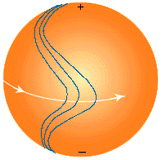
Differential Solar rotation; twisting of magnetic field
In the end, this differential twisting of the Sun's magnetic field will result in a reversed pole, as we know from observations. Something similar may take place inside the Earth's inner core as well. But the mechanism here is not the 'reconnection' of magnetic fields, though this may happen. Actually, what is being hypothesized is that once the fields have come completely around, a new concave driven dynamics comes into play, in effect, to reverse spin. However, this is impossible, as the mass angular momentum cannot be reversed. Therefore what is the default, that magnetism reverses instead, is what drives the poles reversal.
Wacky idea? Totally loony toons!  But that's what a burned out radiometer can do... I'm beginning to like this Crookes effect. But that's what a burned out radiometer can do... I'm beginning to like this Crookes effect.  Of course, this requires a micro 'black hole' dynamics to work, driving differential spin from the inside. Of course, this requires a micro 'black hole' dynamics to work, driving differential spin from the inside.
Question: Do galaxies go through pole reversals? Why not, maybe in millions of years?
|
    
Wacky gravity?
| | Posted on Thursday, June 11, 2009 - 11:20 am: | |
the Seven-veils of Gravity?
 (interactive- NewScientist) (interactive- NewScientist)
Why is gravity so weak?
... or is it? Perhaps variable-G 'dark matter' or black holes are not wacky ideas?
Why does gravity only pull, when nature is duality in all other things... or is it?
Could gravity's opposite force be e.m. energy?
Why is quantum gravity so wacky? |
    
How old is Life?
| | Posted on Thursday, June 18, 2009 - 11:07 am: | |
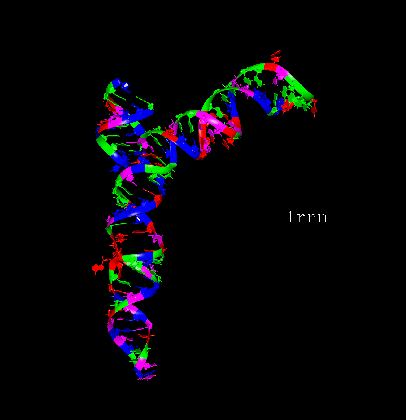 (interactive- Space.com) (interactive- Space.com)
Could Life be 12 Billion Years Old?
Of course this is contingent upon the current cosmology model of the wacky Big Bang origin, some 13.7 billion years ago. But if the universe is much much older, then the 12 billion tag is for our local observable universe only, since Life may in fact be nearly as old as the real universe, perhaps infinitely old...
quote:For life as we know it to form and thrive, four conditions must be met: sufficient amounts of the so-called biogenic elements, a solvent (on Earth, that solvent is liquid water), a source of energy, and time "for the elements to build up and create a home and conditions for life to thrive," Venkatesan explained.
The biogenic elements include carbon, nitrogen, oxygen, phosphorous, sulfur, iron, and magnesium.
Still, a good article worthy thinking about. Could this be how Life started? If we are direct descendants, are we 12 billion years old? Each one of us?... Think about it! |
    
Hollow Earth?
| | Posted on Sunday, June 21, 2009 - 12:08 pm: | |
Hollow Earth - a dream consciousness?
I think of dreams as tiny bubbles of consciousness forming deep inside the brain and floating to the surface to burst into either normally coherent or fantastically wild stories. My dreams from inside -a still reconstructing brain- can at times take on very vivid reality, and often come remembered. One such post-stroke-reconstruction dream was a vivid account of Cinzia and I accepting an invitation to summer at the South Pole, where the brochures promised cruises, good company, fine cuisine, and interesting science seminars at a vacation base. Who could refuse? 
We somehow got there, by plane I think, and the place had a dark eery atmosphere, though well lit locally, like the sky was night time but there was a superimposed map of the world on a large globe in the sky. On that globe, which literally took over the overhead sky in the inky background, there was a light shining on a part of it. It looked like where the Sun would be shining on it during the day. I even pointed out to Cinzia, who was busy making friends with an old woman who vacationed there regularly, that the light was shining over the United States region, though we were looking at it from south of the Equator. Also, the sea at this vacation base was very calm, of a coppery blue color, except for one wave which was very large, tsunami like, and it was coming at us. We braced ourselves by hanging on, but it never reached us and broke up earlier. Otherwise, there was no snow on the ground except when we were walking outside the vacation base, and then it was old crunchy wintry snow on which we walked in accompanying the old friend to her apartment complex. There were also many Japanese visitors, the bathrooms were unisex and clean, and the food was very good. I can't remember much more except that it was mostly very quiet there, it felt like we were on a cruise of some sort, small pleasure cruise boats were coming and going, inside the base it was warm but outside cold, the sky became totally dark when the solar rays moved beyond the horizon. But the whole place felt as if we were deep inside the Earth, and the overhead was a projection of what was going on outside, but there was no moon. Was this a 'hollow Earth', or Agartha dream?
 
Imaginary 'hollow earth', imaginary inner torus base (images interactive)
So what does the brain make of this dream? Not much more than the one I had just earlier, about wood chips. Just a fun thing to remember, that our dreams are little bubbles of consciousness, and they don't have to make sense.  Just enjoy the moment, as the brain talks to itself in its own bubble babble. Just enjoy the moment, as the brain talks to itself in its own bubble babble.
 (interactive) (interactive)
Nuclear Soviet icebreaker Yamal- not in the dream
Who'd a thunk it anybody would believe this wacky cruise charter, a trip which never took place to enter the Agartha 'inner Earth' from the North polar sea? Didn't they know it's in the Souih?! 
Yatahay! |
    
How UFOs fly
| | Posted on Sunday, August 09, 2009 - 12:26 pm: | |
NASA to reinstitute 'wacky ideas' dept. Bring it on! 
Report Urges NASA to Resurrect Advanced Concepts Institute
quote:The report, released Friday, recommended that the space agency revive the NASA Institute for Advanced Concepts (NIAC), which was shuttered in 2007, or replace it with a similar innovation-focused entity in order to "seek out far-reaching, advanced concepts with the potential of significant benefit" to NASA's charter and future missions.
...
According to the report, a new NIAC entity should report directly to the office of NASA Administrator Charles Bolden, and be managed separately from other agency mission divisions. Initial grants for the new program could fund studies with up to $100,000 for a year in a Phase 1 approach, while a Phase 2 level could set aside up to $500,000 over two years for innovative research.
 (interactive) (interactive)
How UFOs Fly - per article 25 July, 2005
http://www.unknowncountry.com/ |
    
More plasma fun
| | Posted on Tuesday, August 25, 2009 - 01:39 pm: | |
Plasma fun, the videos.
What part do these anecdotal videos play in plasma propulsion?
Micro black holes again? Another 'hot' version of radiometer above?
 (interactive - video) (interactive - video)
More of same Note how plasma gas gathers at top into a rotating torus?
More on YouTube related pages. |
    
Flying mirage
| | Posted on Friday, September 18, 2009 - 09:57 pm: | |
Flying wing mirage, YB-49..
Were they all destroyed? This reads like a mystery novel. After WW II Nortthrop developed a 'flying wing' which crashed and burned upon testing, and later all remaining built planes were destroyed. Some thought it was sabotage. However, what I saw a few days ago looked very much like the YB-49 in 'silent' flight over southern California.
 (interactive) (interactive)
YB-49 Flying Wing by Northrop
I first though I saw the faint silhouette of a large night owl seen through the branches of a tree, but when I followed it in the dark as it cleared the tree, I thought I was seeing a mirage of a large flying wing silently gliding through the night sky. It traveled northwest to southeast over what from its point of reference would have been over the coast of Orange County in southern California. But I couldn't be sure, because it had no engine noise, no flashing lights, no lights at all except for the eerie glow from beneath, more like a reflection of city lights, as it quickly disappeared into the night sky. It did seem to glow of its own light, very faint, like a low amber light with no running lights at all, and no sound. It was fast too.
I immediately dismissed it, thinking I was seeing things, or some sort of UFO, when over these past days a strange idea kept insinuating itself to me. The image of a flying wing in the night sky was not a UFO but a test plane reincarnated from the old YB-49 era, with a new engine aboard, one silent that gives off a faint glow. It moved quickly enough to make me think it was a jet, but no sound at all. What was it, this flying wing 'mirage', my mind kept asking subconsciously?
However, as this flying wing concept was inherently unstable, why would anyone be bringing it back now, except on an experimental basis? And that's what my mind read, that this above silent, lightless plane was an experimental run of a new kind of engine based on a whole new kind of physics. I imagined, more like a mirage, that aboard was a spherical vacuum container within which was high spinning hot gas plasma, so its self gravitating spin was generating a radiating axial light energy, which covered the whole plane with a faint eery light. But more importantly, it boosted the vessel's lift by lowering its 'inertial mass' (lower G aboard), so it took very little to maneuver the craft with silent engines and great stability. The axial jets of energy were covering the whole body of the craft, which is what gave its eerie light. This would be new physics, and it would be revolutionary to say the least. But I am only reading my imagination and have no way to confirm any of this, except as an apparition or mirage of what I saw. It definitely was not a B-2, which I had seen in night flight over Oklahoma. So what was it?
Could our Air Force be testing an experimental plane over the southern California coast, flying it from Edwards Base? The base was named after a pilot who died in the second test of YB-49, so why not? But it must be 'above Top Secret' if so, and we may never know until a fleet is produced in some future. For now, I will treat it as another UFO. If its our own, we will learn it by and by. But why test it here, with no running lights? Unless... it was to give the city lights a show? ;)
(Also see 5 UFOs? posted Oct. 5, 2002) |
    
More 'flying mirage' NASA
| | Posted on Saturday, October 03, 2009 - 12:59 pm: | |
Another 'flying mirage' mystery, this one from Space Shuttle.
Great YouTube video of 'flying mirages' in space.
See the 10 mins video: http://www.youtube.com/watch?v=sGiDAhWEQ_4&feature=related
This dovetails in with the other post on Post Cards: UFOs -or 'Klingons' watching us?
Are we being watched? ... Not so 'wacky' idea.
 ... they're here. ... they're here. |
    
just a matter of G?
| | Posted on Monday, October 12, 2009 - 12:08 pm: | |
2 Pallas and Enceladus both have almost same diameter of ~ 550 km.
BBC Science News - Pallas is 'Peter Pan' space rock
Why are they so different? Only real difference is 2 Pallas is at about 3 AU, while Enceladus is at about 9.5 AU, and that at 1G per AU makes all the difference. One remains an ill shaped asteroid, while the other is a fully round planet-like moon.
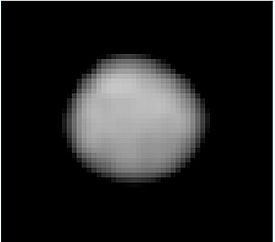 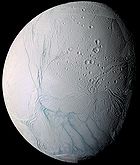
Asteroid 2 Pallas; Saturn moon Enceladus
Enceladus even has a tenuous atmosphere, something impossible at 3G, but it can happen at 9.5G. Time to change our "wacky" thinking of how formed the solar system? It's just a small matter of G?
Even at 9.5 G, it is still a very weak (@ 10^-11 range) gravitational force. |
    
Mars rock
| | Posted on Monday, November 09, 2009 - 01:07 pm: | |
Bring back a piece of the 'rock'.
 (interactive) (interactive)
Nasa and Esa sign Mars agreement - BBC News
If NASA-ESA joint venture succeeds in bringing back a piece of Martian rock, it would be advantageous to have its density measured both on Mars and on Earth for comparison. This may offer a surprise, per the 'variable G' hypothesis.
quote:The union will start with a European-led orbiter in 2016, and continue with surface rovers in 2018...
The ultimate aim is a mission to return Mars rock and soils to Earth labs.
Stay tuned... Not as 'wacky' an idea as it seems, as discussed earlier here: Clumpy Kg in G, resolved.
Neither 'wacky' when they bring back a piece of rock from Mars: New Mars Missions to Focus on Search for Life. Will it 'weigh' the same 'density' on Mars as it does on Earth? Like angular momentum?... Serious question, if Newton's G is a variable. |
    
Water moon
| | Posted on Saturday, November 14, 2009 - 11:02 am: | |
Fly to the Moon and take a bath. 
Why go to our nearest celestial neighbor to built a colony? In fact, our moon is water rich, good for making hydrogen, etc.
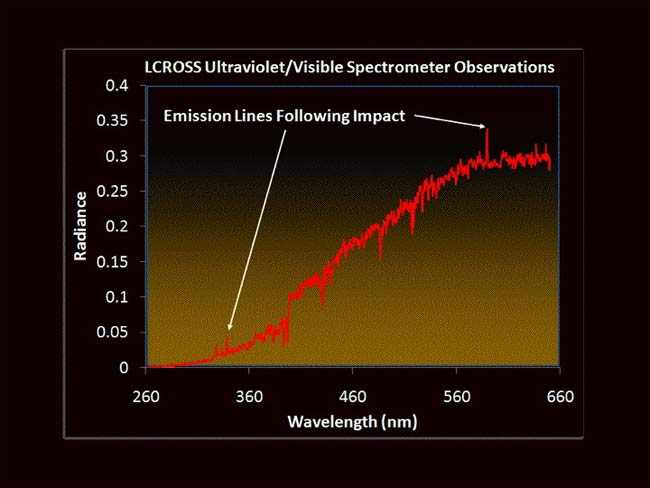 (interactive) (interactive)
'Significant Amount' of Water Found on Moon - Space.com article
quote:Based on the measurements, the team estimated about 100 kilograms of water in the view of their instruments — the equivalent of about a dozen 2-gallon buckets — in the area of the impact crater (about 66 feet, or 20 meters across) and the ejecta blanket (about 60 to 80 meters across), Colaprete said.
"I'm pretty impressed by the amount of water we saw in our little 20-meter crater," Colaprete said.
Where there is water, there is life. Well, on the Moon not yet, but it may be true for a universe filled with water, life gets around.
This just in: Cave discovered on Moon could be home for humans - BBC (July 2024} |
    
Le Chef
| | Posted on Sunday, December 06, 2009 - 01:33 pm: | |
Gravity shmarity, I'm running out of patience with you humans...

... but us lapdogs are very willing to accept you unconditionally...

... Le Chef returns!  |
    
redshift
| | Posted on Tuesday, December 08, 2009 - 11:32 am: | |
The further we look, the more we see - red.
[Just in, 13.2 billion year old galaxy (vs. 13.7 billion 'age' of universe) that really shouldn't be there, not enough 'time'? Cosmic Lens Unveils Oldest Galaxy - Sept. 19, 2012 - Discovery News]
Surprise, but looking some 13.1 billion light years yields a universe full of fully formed galaxies, and this is up against a 'Big Bang' universe allegedly originated 13.7 billion years ago. Of course, the light is very 'stretched by an expanding universe', so believed, so what we are seeing now in highly red shifted light is what it looked like 13.1 billion years ago. But if light is stretched gravitationally through very high deep space gravity G, then this whole exercise in why the 'early' universe is already so well populated with fully formed galaxies is moot. The real question is can we see beyond the gravitationally redshifted light spectrum, or does light simply disappear from our vision? Looking beyond the distance where is the CMB, light is so stretched the universe remains dark to observations, which validates Olbers' paradox, as the universe there is invisible to us, all black. Of course, ditto, the whole universe expansion Big Bang is specious, and hopefully will be better understood as nonsense very soon. Let's move on in astronomy, we've been stuck here too long, Mr. Einstein et Fr. Lemaitre.
 (interactive - click image for article) (interactive - click image for article)
NASA's Hubble Space Telescope has made the deepest image of the universe ever taken in near-infrared light. The faintest and reddest objects in the image are galaxies that formed 600 million years after the Big Bang. The image was taken by the new Wide Field Camera 3 in the same region as the Hubble Ultra Deep Field (HUDF), which was taken in 2004 and is the deepest visible-light image of the universe. Credit: ASA, ESA, G. Illingworth (UCO/Lick Observatory and the Univ. of California, Santa Cruz), R. Bouwens (UCO/Lick Observ. and Leiden Univ.), and the HUDF09 Team
- Space.com news
Here is one more example: Galaxies in Young Cosmos More Massive and Mature than Expected
It shouldn't be, but there it is.
________________________________________________________________________________
Watch for news from ESA Herschel 'infrared' deep space telescope, with periodic updates.
As the universe turns... First Galaxies Born Sooner After Big Bang Than Thought - April 2011
Also see: Spatial Fluctuation of the Hubble "Constant" (Pecker, Vigier, Jaakkola - 1975/1990)
________________________________________________________________________________
Addendum: Just a note on newly glimpsed "accelerating expansion" of the universe, so believed. Within the last 5-6 billion years or so, universal 'expansion' seems to be accelerating, per this Scientific American article:
quote:But has the cosmic expansion been speeding up throughout the lifetime of the universe, or is it a relatively recent development— that is, occurring within the past five billion years or so? The answer has profound implications. If scientists find that the expansion of the universe has always been accelerating, they will have to completely revise their understanding of cosmic evolution.
In fact, it appears that this 'accelerated' expansion observed is apparent at about 5-6 billion years ago, or about 8 billion years after the presumed Big Bang origin of the universe. But why is this significant?
If the universal expansion is due to Doppler redshift, then an acceleration from about ~40% back in time would need an exotic explanation, such as higher 'dark energy' at about that time. This is what is assumed by cosmology at present. But if this expansion is due to optical factors, such as gravitational redshift through higher gravity-G regions of intergalactic space, rendering its observation merely an optical illusion, then other causes would be needed to explain it. And if so, then perhaps cone geometry is all that is necessary to understand this 'optical' phenomenon. It would work something like this, assuming supernova type 1a candles are correct:
If diffuse gas and atoms are scattered within the light-cone of visibility from billions of light years within a higher G (about 4.5 orders of magnitude greater than Newton's G on Earth) in deep space, then light traveling through the diffuse atoms of space would encounter greater mass density closer in to us than farther away. Therefore, much like light hitting greater density of water, it would tend to refract at some point within that light-cone where the diffuse atoms density reaches some 'critical mass' within line of sight. This may be happening at about 6 billion light years, as the concentration of diffuse atomic space atomic mass gains greater density (within the line of sight geometric cone), where it is very diffuse beyond 6 billion years, but gains in density as it comes in closer to us and cone narrows. So, if redshift is from natural higher G gravitational redshift (meaning there is no expansion, merely an illusion), then as it crosses that 6 billion years boundary it 'refracts' into higher redshift, which now gives an illusion of accelerated expansion. (Could the ‘acceleration’ of the universe Big Bang, so called, expansion be a deep space high gravity artifact, a kind of ‘thermocline’ of how gravity affects distant lightshift in the light cone about half way from its ultimate visible distance 13.7 billion light years away?) Ergo, higher space atomic density in higher G means higher redshift, today understood as faster universal expansion, within the light cone as it narrows approaching Earth; think of projective geometry in reverse; and that is all it need to be to give the illusion of accelerated expansion.
Therefore, ‘accelerated’ expansion some 6 billion years ago may be merely an artefact of gravitational lensing on a cosmic scale, where distant light passing through much higher G over billions of light years ‘decelerates’ in higher line-of-sight gravitational redshifting to appear ‘more redshifted’, now interpreted as ‘accelerating’ cosmic expansion; in fact, it may be simpler than that, merely an artefact of ‘lensed’ deep space higher G redshifting light passing through it.
If that is all it is, then the mystery of "accelerating expansion" is easily solved, without the ad hoc exotic 'dark energy' currently imputed. It is merely the strangeness of a variable-G in how the universe works, and has nothing to do with any presumed Big Bang (Doppler) expansion of the universe. Now, isn't that more satisfyingly simple? Simple optics geometry is all it is.
Also consider this, just in (2014):
Most Ancient Star Lurks on our Cosmic Doorstep
quote:MSS J031300.36-670839.3, however, has no detectable sign of iron. Even within the margins for error, and astronomers assume an upper limit on the quantity of iron it contains, the star is still dated 13.6 billion years old. Previous “oldest star” record breakers have been dated to 13.2 billion years old.
Let there be light: Cosmologists reconsider epoch of reionization
quote:In a paper published Thursday in Nature, researchers are challenging one long-held conception about how quickly the universe began warming during this transition period. …
According to scientists, the reionization period began several hundred million years after the big bang, when neutral hydrogen and helium particles began to condense into clouds…
The period ended about 1 billion years after the big bang.
How do we rectify both these two reputed dates? Earliest star near us is only two hundred million years old, but 'reonization' took a billion years? How far back in time is the Big Bang?… Or was it never was.
Also see:
MOND Revisited, why it is valid
First stars in telescope's sights (2007 BBC)
General Relativity's gravity waves 'falsifiable'?
Some Big Bang, modern Cosmology peculiarities
This just in (2016):
Hubble sets new cosmic distance record
quote:The Hubble Space Telescope has spied the most distant galaxy yet.
It is so far away that the light from this extremely faint collection of stars, catalogued as GN-z11, has taken some 13.4 billion years to reach us.
Or to put that another way - Hubble sees the galaxy as it was just 400 million years after the Big Bang.
Of course, if they see red beyond this point, they'll have to move back the date for Big Bang (never happened) beyond 13.8 billion years.
This just in, 25 Dec 2021:
James Webb Space Telescope lifts off on historic mission - BBC
(What will they see beyond 13.5 billion light years away? Fully formed galaxies?)
12 July 2022 - First Images from the James Webb Space Telescope -NASA
November 18, 2022 - Webb Telescope Captures Oldest Galaxies Yet Seen
quote:Garth Illingworth at the University of California-Santa Cruz, the co-author of the article in the Astrophysical Journal Letters, told reporters “We are seeing such bright, such luminous galaxies at this early time, that we’re really uncertain about what is happening here.”
This just in: Webb telescope makes a surprising galactic discovery in the distant universe - CNN (22Feb 2023)
quote:The space observatory revealed six massive galaxies that existed between 500 million and 700 million years after the big bang that created the universe. The discovery is completely upending existing theories about the origins of galaxies, according to a new study published Wednesday in the journal Nature.
James Webb Space Telescope - Wikipedia
quote:On 12 July 2023, NASA celebrated the first year of operations with the release of Webb’s image of a small star-forming region in the Rho Ophiuchi cloud complex, 390 light years away.[273]
In September 2023, two astrophysicists questioned the accepted Standard Model of Cosmology, based on the latest James Webb Space Telescope studies.
NASA’s James Webb Space Telescope Finds Most Distant Known Galaxy - WEBB Space Telescope (30 May 2024)
quote:Using Webb’s NIRSpec (Near-Infrared Spectrograph), they obtained a spectrum of a record-breaking galaxy observed only two hundred and ninety million years after the big bang. This corresponds to a redshift of about 14, which is a measure of how much a galaxy’s light is stretched by the expansion of the universe. ...
"All of these observations, together, tell us that JADES-GS-z14-0 is not like the types of galaxies that have been predicted by theoretical models and computer simulations to exist in the very early universe. Given the observed brightness of the source, we can forecast how it might grow over cosmic time, and so far we have not found any suitable analogs from the hundreds of other galaxies we’ve observed at high redshift in our survey.
|
    
Gort
| | Posted on Wednesday, December 09, 2009 - 12:31 pm: | |
Gort is here

a long way from home

watching watching listening |
    
Good by Rover
| | Posted on Saturday, December 12, 2009 - 01:58 pm: | |
Good by Spirit Rover, we will miss you, until our return...
 (interactive) (interactive)
Wheel Trouble May Doom Stuck Rover on Mars - Space.com
quote:After months stuck fast in deep Martian sand, NASA's embattled rover Spirit is facing a debilitating wheel problem that has slowed its escape efforts and could paralyze the long-lived robot.
Spirit has been trapped wheel-deep in sand for nearly eight months and engineers on Earth have been spinning the Mars rover's wheels in recent weeks to try and force it free. But the rover's right-rear wheel has been stalling, and now may be broken for good.
Now with Mars orbiters failing, it is grim. Good by Mission Mars. |
    
Life is bacterial
| | Posted on Friday, December 18, 2009 - 12:33 pm: | |
Mars 'life' may leave a bacteria trail clue.
Here is an idea that may have universal applications in finding 'life' on other worlds, all of them:
How to Find Signs of Life on Mars (2009)- Space.com

On sandy beaches microbial mats composed of cyanobacteria form characteristic structures. The left column of this figure shows modern structures, the right column the fossil counterparts. Credit: Noffke, 2009, Earth Science Reviews - Space.com
In a related article: Ancient Fossils or Just Plain Rocks? (2003)
The same idea is presented, that here on Earth may be traces of how this bacterial colonization first started, records still traceable in rocky fossils to be looked for on other worlds.
Some of this was also mentioned on Humancafe forums at: Are Blueberries on Mars a 'strange' life form? (2009)
Also, Martian life may lie under its permafrost, see Humancafe post: Where's the Life on Mars? (2008)
Including this article about 'polygons' on Mars: Mars scientists ponder polygon mystery (2008)
 (interactive photo) (interactive photo)
Canadian tundra polygons
 (interactive -NASA) (interactive -NASA)
Phoenix Mars Lander images of Martian polar polygons vs. Antarctic summer on Earth
Not so "wacky" ideas? All these images may be related to life, especially bacterial?
Life is persistent, durable, and universal to all the planets, and perhaps the whole galaxy as well... Also see 30,000 year old microbial life in salt crystals --
Also: Viruses: The unsung heroes of evolution -- NewScientist articles
This just in: What’s creating oxygen on Mars? |
    
'black hole' in a lab
| | Posted on Tuesday, December 29, 2009 - 02:49 pm: | |
Black Hole in a lab?
First black hole for light created on Earth, NewScientis (2009) article.
 (interactive) (interactive)
Can we re-create a supermassive black-hole?
This is not quite what I had envisioned per Ryoji Matsumoto's simulation of a 'black hole' which approximates the Axiomatic Equation's hypothesis: that if all lambda cancels on a point, extreme 'black hole' gravity results, i.e., center of any galaxy. But the fact they are looking into it makes it intriguing.
Of course, it is only a matter of time for us to duplicate this process artificially and generate a new, perhaps inexhaustible, source of usuable energy to power our engines, possibly space engines with unlimited acceleration over time. The possibilities are staggering with this 'loony wachy' idea!  "Fire in the hole!" "Fire in the hole!"
Ps: as an aside, they're getting closer to understanding what galactic black holes are really all about: Supermassive black holes – the fathers of galaxies - NewScientist article - but they still don't get the full picture, as per Axiomatic Equation, that when all energy lambda cancels on a point, extreme gravity G exists, just like the center of every galaxy.
Also see: MOVED-G force motor (patent pending) |
    
AU^-1/2 in cm is Pioneer Anomaly?
| | Posted on Friday, January 08, 2010 - 12:00 pm: | |
(AU)^-1/2 in cm is Pioneer Anomaly?
The Pioneer Anomaly reduces simply to the inverse distance square root of an astronomical unit? Hence, PA=(AU)^-1/2 ??
(No square root format?) Can this puzzling phenomenon of our solar system be that simple? Or simply rubbish?
Let's take a look at what is said in the "Variable G" paper: A VARIABLE MASS PER VARIALBE G HYPOTHESIS, AS A MODEL FOR THE ANOMALOUS ACCELERATION OF PIONEERS 10 AND 11 -- per the Equivalence Principle and the Axiomatic Equation. (2006)
The paper says essentially that if the energy radiated from the sun on a point is multiplied by its distance from the sun (works better using kilometers??), presumably to measure some solar energy density (Joules per meter squared?); then if this result is multiplied by the planet's orbital kinetic energy (for 1 kg mass?), the total energy represents some model energy for that planet in orbit (see paper how worked out for each planet), which is E=9E+16 Joules for Earth. Then, if the de Broglie-Planck quantum equation (E=hf) is written to show proton mass (E=hc/[lambda*proton]), and this is applied against Einstein's famous equation modified to show some proton-gravity relationship; and this is further reduced to a facsimile of Newton's G, then we have the delta G per AU, which works out to be approximately 1G per 1AU. So the Pioneers 'wacky' Anomaly is simply the delta G variable per Newton's G, which works out to about 'one'; and this is per the distance of 1AU, viz. 1/(AU) in centimeters, which per Equivalence Principle requires this function to be a square root of AU, so the result is: (1/AU)^1/2, or better yet: (AU)^-1/2 as the 'pure' Anomaly for the Pioneers in centimeters per seconds squared.
Let's follow this trail and see if it takes us there, per the Variable G paper.
From 3.1: Acceleration of the Pioneers towards the Sun:
delta G = 7.239E-11 m^3 kg^-1 s^-2
Newton's G = 6.67E-11 m^3 kg^-1 s^-2
1AU distance = 150E+9 meters
So working it out as per above:
delta G/ Newton's G/ 1AU = 7.239/6.67/ 1AU = 1.085 (dimensionless ratio?) which is further divided by 1AU:
1.085 / 1.5E+11 meters = 0.7233E-11 (dimensionless? or m^2 kg^-1 s^-2? - acceleration per one kilogram mass?) but this is then modified for the Equivalence Principle (where delta G grows at 1G per 1AU causing mass to increase proportionally as its square root?) so we get (0.7233E-11)^1/2 in meters = (72.33E-13)^1/2 in meters, or (72.33E-15)^1/2 in centimeters, which taking square root is (dimensions adjusted?):
-a = -8.505E-7.5 cm s^-1/ s kg (dimensions adjusted per second - per kg??)
vs. actual measured anomaly: -a = -8.74E-8 cm s^-2 (approx)
As the paper shows, this is merely an approximation, but pretty close. If so it is either revolutionary to astronomy - or simply rubbish. What is it?

"You wana hand sandwich?... Uuummmrph!... What's the idea?.... Ouch!!"
If that's all there is..? What will 'Curly' Einstein think?

Have your say...
Scheptik |
    
RE 1/AU^1/2
| | Posted on Tuesday, January 12, 2010 - 01:01 pm: | |
RE (1/AU)^1/2
quote:So working it out as per above:
delta G/ Newton's G/ 1AU = 7.239/6.67/ 1AU = 1.085 (dimensionless ratio?) which is further divided by 1AU:
1.085 / 1.5E+11 meters = 0.7233E-11 (dimensionless? or m^2 kg^-1 s^-2? - acceleration per one kilogram mass?)
Thanks Scheptik, I think the above mentioned can mean "acceleration per meter, per kilogram", or more to the point:
1.085 / 1.5E+11 meters = 0.7233E-11 m^2 kg^-1 s^-2, which is same as 72.33E-15 cm/s^2 (per cm/kg),
which taking the numerical square root becomes:
a = -8.505E-7.5 cm/ s^2 as calculated using centimeters (vs. 8.74E-8 cm/ s^2 observed)*
This makes the Pioneer Anomaly acceleration a function of both distance and mass in a variable G system.
Just my thoughts on this, and as I mentioned in the original paper, the reason Pioneers has lower acceleration than calculated is perhaps due to on board heat factors.
Funny graphics. Is that the Ricci tensor on the board? 
Also see: Total Planetary Energy short hand
Summing up Variable-G gravity hypothesis |
    
Electro-weak, super-density stars?
| | Posted on Sunday, January 17, 2010 - 02:23 pm: | |
Are these gazillion pounds 'weaklings' really electro-weak stars?
 (interactive) (interactive)
Exotic stars may mimic big bang (NewScientist)
quote:Now, a study led by De-Chang Dai of the State University of New York in Buffalo says the deaths of very massive stars may lead to "electroweak" stars that creep even closer to the black hole limit (arxiv.org/abs/0912.0520).
The cores of these stellar corpses can reach the same density as that of the universe 10-10 seconds after the big bang. At that point, the distinction between the electromagnetic and weak nuclear forces breaks down.
Whether or not the Big Bang's 10-10 seconds happened is irrelevant and secondary to what happens when all energy lambda is weakened down to where total gravity takes over. That is the question. The Axiomatic Equation says "yes". |
    
Newton's Apple
| | Posted on Monday, January 18, 2010 - 11:56 am: | |
Newton's apple, the Real story:
http://www.newscientist.com/blogs/culturelab/2010/01/newtons-apple-the-real-stor y.php
"Meanwhile, three and a half centuries and an Albert Einstein later, physicists still don't really understand gravity. We're gonna need a bigger apple."
Get a bigger apple!  |
    
Planet Ratio always One?
| | Posted on Friday, January 29, 2010 - 02:04 pm: | |
Planet Spin Ratios always equal to One? Approximately?

Let's see if we can make any kind of sense out of this, since the idea is preposterous, if not rubbish. How can spin ratios for the planets all be equal to one? There must be a hidden error here, so let's look for it.
The basic premise according to paper on Planetary Spin, viz. http://www.humancafe.com/discus/messages/88/97.html#POST5032 (original linked in post), claims that Venus is used as a base zero for this formulation, and Earth's spin as base one. The spin ratio is a function of interior planet heat expressed as Kelvin, and of orbital energy in Joules (expressed per the Axiomatic Equation), per the paper.
The equation is written in a very confusing style, so let's rewrite it here better:
Venus = (231.7K/17.33E+16 J) = 13.36E-16 Kelvin/Joules (this is a constant, product of Venus Kelvin black body temp divided by orbital energy?)
Earth = (254.3K/9E+16J) ÷ (13.36E-16) * [(254.3K/231.7K)] ÷ (365/365) ÷ [(1)*(1)] = 2.32 (this is the Earth 'ratio' of spin per the SR equation, Spin Ratio?)
Planet's Kelvin to Energy ratio = K/E (for any planet)
The SR equation works out to be:
[K/E] ÷ (Venus constant)*(planet K/Venus K)÷ [planet's orbital days/365 Earth days] ÷ [(planet's spin)*(AU^1/2) = SR (spin ratio)
(Note, interesting how the "planet spin" is incorporated into the SR equation. How can this SR equation be used to figure "planet spin" from all the other variables of Energy and black body Kelvin? Unless SR value equals some same constant, so both Venus and Earth are "netted out", it serves no useful purpose.)
For Earth, the SR works out to be = 2.32 (as shown above, base spin rate of 1 day spin), so this must be the constant with which all else in these equations have to work out. If ALL the SR results are then divided by this base rate, they should all be equal to = 1, if this SR equation is true. But does this really work?
What if we took out the daily spin from the above, and worked the numbers for SR? The new equation would be as above, with planet spin omitted, figured at 1/AU:
[K/E] ÷ (Venus constant)*(planet K/Venus K) ÷ (planet's orbital days/365 Earth days) ÷ (1/AU^1/2) = SR (non-spin ratio?)
Here are the computed SR for each planet: (note, Venus 231.7 Kelvin is cooler than Earth's 254.3K!)
Mercury = (7.3E-16 Kj)÷(13.36E-16 Kj)*(1.74) ÷(0.241)*(0.624) = 2.46 SR
(vs. 0.0456 in original)
Venus = (13.36E-16)÷(13.36E-16*(1) ÷(0.67)*(0.85) = 1.42 (out of line SR?)
(vs.0.005 -retro- in original)
Earth = 2.32 (base of SR=1)
Mars = (54.43E-16)÷(13.36E-16)*(0.907)÷(1.88)*(1.225) = 2.408
(vs. 2.25 original)
Jupiter = (328.36E-16)÷ (13.36E-16)*(0.475)÷(11.86)*(2.28) = 2.244
Saturn = 2.212
Uranus= 2.37
Neptune = 2.33
Note: Divide all these above by Earth's 2.32, and you get approximately =1, when spin is NOT included.
What really happened here? That Kelvin black body temps has a relationship with orbital solar energy received, but not spin related as far as we can tell, unless you add in the spin in the first place. Not meaningful. All this accomplished in the end is if you divide SR by Earth's 2.32, it equals to one, approximately.
[In following the links, we come accross this discussion on Bad Astronomy. So this was discussed already, five years ago! Nothing resolved then: http://www.bautforum.com/against-mainstream/17004-planet-spin-function-interior-heat.html . It FAILED then, as it fails now. Planet spin has no relation to interior heat as it stands. As such, SR is rubbish. But there is an (1/AU)^1/2 relationship that means "something", though at present don't know what. Why should this figure bring it all to unity?]
What is the significance of (1/AU)^1/2 in this solar energy to planet Kelvin relationship? This may be the REAL question here: Why is 1/AU^1/2 a meaningful value in planetary solar energy system, or the 'unity' of energy relationships? Are the outer planets progressively hotter K inside (by 1/AU^1/2), and cooler towards the Sun? Why would that be significant? Is there some sort of 'energy equilibrium' in our solar system? Interesting...
Scheptik
(Please see more on this below posted May 11, 2011- IDA) |
    
"I dunno"?
| | Posted on Saturday, January 30, 2010 - 03:51 pm: | |
Pretty cool, Scheptik. You took it to the next level! 
quote:Why is 1/AU^1/2 a meaningful value in planetary solar energy system, or the 'unity' of energy relationships? Are the outer planets progressively hotter K inside (by 1/AU^1/2), and cooler towards the Sun?
This is "puzzling" indeed, now that you mentioned it. Perhaps as a simple ratio of planet's Kelvin temp to Joules orbital energy calculated, it appears to increase in relative value (but not at the 1/AU^1/2 rate; Viz. Mercury: 7.3, Venus: 13.36, Earth: 28.2, Mars: 54.4, Jupiter: 328.4, etc.). The progression is mysterious, as to why internal/black body temps would increase with distance from the Sun. Perhaps, just a maybe, the 1/AU^1/2 gravitational relationship translates into greater internal planetary heat from the higher G pressures, when going out solar system?
Must think on this some more, maybe in five more years? What does it all mean? Why is there even any relationship parity here? I am puzzled, so for now must answer "I dunno."

|
    
Equilibrium charge-gravity?
| | Posted on Wednesday, February 03, 2010 - 02:45 pm: | |
Can deep-space gravity (G+) equal Weak-force positive (+) charge 'monopole'?
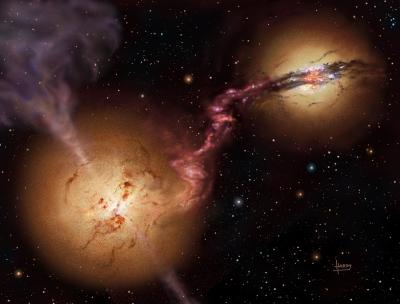 (interactive - video) (interactive - video)
Big interactive stellar galaxy forces at work
This is a very belated answer to Naive's question from two years ago:
quote:In the absence of any large body (that could potentially cancel out the gravitation between small objects), what would be stronger:
The gravitation between two oppositely charged particles or
The electromagnetic attraction between the same two particls?
This idea was recalled much later when considering a single magnetic mono-pole charge, not shown to exist experimentally (to date), only theorized. This was later again brought to mind when I looked up the Weak force of the four forces of the Standard Model of particle physics. This then refers back to another post by Naive last year, wondering how would two stars of equal charge interact:
quote:Here's another question: Suppose we coud design two, star-sized magnets (both in mass/density) that were similarly charged. Would they repel each other in space or collide? In other words, In physics the electromagnetic force is supposed to be stronger than gravitation. Is there a limit, however, where the sheer scale of mass will cause gravitaion to "win out" over the electro-magnetic force? What if they were traveling toward each other at tremendous speeds? What role would that play?
So putting these two together, I began to formulate over the many months past, however crudely, what this might look like.
1) The first thought went back to the idea that galaxy centered 'black holes' generate axial jets of positive charged proton ions, or proto-hydrogen atoms, which are expelled at near light speed out of both jets (negative charged electrons may also be expelled). If these are positive charged when expelled, they would expect to remain with same charge as they distribute randomly in the space beyond the galaxy. So think of positive charged 'monopole' proto-hydrogen atoms floating randomly in deep space repelling each other due to like-charge.
2) The second thought is that the Weak force, which is at 10^-6 range (extreme short range) is similar to the gravity G 'constant' of deep space (see #5 & 6), which is also in the 10^-6 range (infinite). So now the proto-hydrogen is both positive charged and gravity powered, assuming a monopole Weak force, or electroweak charge interaction, at an equilibrium of approximately 10^-6 force range for both gravity and Weak force.
3) Therefore, at the deep space equilibrium range of 10^-6 force for both gravity and charge, where the Weak force is in equilibrium with the very high gravity of deep space, there results a force neutral for all proto-atoms floating in space, where their similar charge repulsion will counter equally their high gravity attraction. In effect, they are free atomic ions in space unconcerned with any other masses around them, until something happens.
4) What happens to these monopole-proto-atoms is they encounter electromagnetic energy, where the e.m. energy splits the monopole into duality, so now the proto-hydrogen atom becomes charge neutral full atom with both a positive proton and negative electron shell. This makes it into an atom with a slight gravity G remainder (per Axiomatic Equation), what we recognize as normal gravity as measured, so it becomes what is known as baryonic 'dark' matter in a low (brown dwarf) energy environment, or ordinary matter in Earth's level G in our vicinity of a hot star, like our Sun. So the result is once e.m. energy encounters these monopole atoms, the photons split into dual charge, anchored as positive at the atomic nucleus, and hovering as negative at the electron shell. This then, by default, becomes the electromagnetic duality of both electricity and magnetism.
5) The end result, if such can be hypothesized, for stars, or galaxies, of similar charge floating in space is that their total gravity is offset by their total electromagnetic energy, so they remain 'free floating' bodies in deep space. Therefore, in the end, they would neither collide nor repel each other from their electro-gravity charge, though they may be moved for other reasons, viz., disturbances in the very small gravity G remainder forces generated by e.m. charge duality.
As a rough 'Post-thought' on the matter: There is room for 'dark energy' of an expanding universe, if the positive charge is greater than its equilibrium gravitational force. But this is unlikely for two reasons: 1) there is no space expansion, the Hubble redshift is an optical illusion caused by deep space gravity G at 10^-6 force range; 2) if the monopole is in equilibrium with G, there is no repulsion nor attraction effect. Dark energy, therefore, is not likely if the universe is in 10^-6 charge and gravity equilibrium. In a 'variable' G universe, "equilibrium" of the four forces is not seconds after the mythical Big Bang, but at the G=10^-6 electro-gravity cut-off (think 'photoelectric effect' analogy) of deep intergalactic space.
_______________________________________________________________________________
Ps: A star formation update: Lonely stars born on a bridge between galaxies
It makes sense, if deep space G is orders of magnitudes higher, so diffuse gases there can coalesce into combustion as stars. -- Eds
|
    
SR Kelvin is Space temp?
| | Posted on Saturday, February 06, 2010 - 07:01 pm: | |
SR = ~2.72 kelvin? In answer to Scheptik comment:
<quote>Is there some sort of 'energy equilibrium' in our solar system? Interesting... </quote>
Pardon my intrusion with something so totally trivial, that space temperature is nearly 3 degrees kelvin,. It seems the argument for planetary spin as pointed out is meaningless, since there is no apparent spin to interior planet temperature relationship. The numerical result is not meaningless, however, if we consider SR may be in kelvin.
It occurred to me doing some simple dimensional analysis of the equation stated earlier where all results approximate SR = 2.32, which is an odd result. The planet's kelvin temperature divided by kinetic orbital energy, then divided by Venus constant which is also same dimensions, therefore cancels out as a numerical dimensionless ratio. Ditto for planet orbital days, they cancel out to dimensionless ratios. If understood right, so does 1/AU square root ratio, which represents delta G over Newton's G, so its dimension cancels into a numerical ratio. The only one that stands out is the planet's kelvin over Venus' kelvin ratio is still temperature, so it may not be canceled out. Temperature remains temperature, so this leaves the equation with a kelvin dimension.
Therefore, SR = ~ 2.32 kelvin, if the right answer is pretty close to absolute zero or space background temperatures.
Interesting.
What amazes is the puzzling result this odd equation gives to all the planets, all having the same SR ratio. Why would the planets' ratios expressed in kelvin come out to a near approximation of space back ground temperature of 2.725 kelvin? This is odd and improbable, but it is an answer that somewhat approximates space background temperature. If I have further insights into this, not likely, I will contact author by private email.
BTW, there is growing suspicion that Pioneer Anomaly, like Global Warming, though well measured may not be from causes believed: http://arxiv.org/pdf/1001.3686v1 (Jan.20, 2010)
IMHO
______________________________________________________________________________
I'm afraid not, IMHO, that 2.32 SR represents Kelvin. It is a 'dimensionless' ratio, has no value other than that. Sorry, though it is an interesting idea.  thanks - Ivan (see May 11, 2011, post below) thanks - Ivan (see May 11, 2011, post below) |
    
Le Quantum Chef
| | Posted on Monday, February 08, 2010 - 12:10 pm: | |
He's Gone Quantum... Look at 'em boots!

Nearing zero kelvin 'loony toons' gone quantum?
Lyrics: "He's gone quantum, here he comes
Yeah he's gone quantum, a new kind of walk
He's gone quantum, a new kind of talk
He's gone quantum, look at them boots"
Le Chef  gone Country gone Country |
    
Spin faster at 50 G?
| | Posted on Wednesday, February 17, 2010 - 01:03 pm: | |
Haumea is an odd egg in our solar system.
 (interactive) (interactive)
Haumea is one of the strangest known objects in the solar system. It is a big across as Pluto but shaped like a cigar or perhaps an American football. These two images show the two extremes of its appearance as it spins. Credit: Mike Brown/Caltech - Space.com
New Views of Our Solar System- Space.com- shows dramatic clarity of the planets and moons, including Plutoids like Haumea , some 50 AU from Sun (Kuiper Belt region), which is shaped more like an American football. Most interesting is its high spin, perhaps why it is elongated on that axis, and its crystaline water composition (at least on surface, high albedo). Water seems to be common in our solar system, from Mercury's surprising water to Martian subsurface water, to it present on the gas giants' moons and Kuiper Belt objects. At ~50 AU where per Axiomatic 'variable G' it resides in ~50 G (Newton's Earth G), the density of this egg shaped object may be overstated, where it may be closer to water's density of 1g/cm3, than that of rock density. (Wiki page has Haumea's density at ~3g/cm3, which may be "overstated" in 50 G, where it "acts as if" it were three times denser.) An all water object would more likely deform, under high spin induced by high G, into the elastic football shape than would rock.
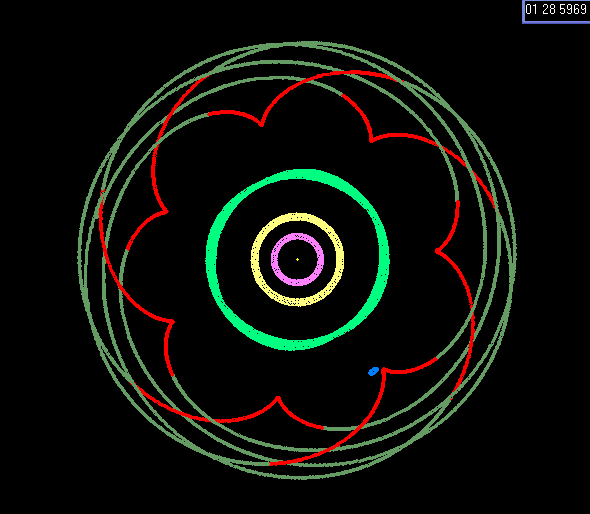 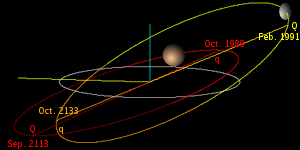
Haumea libration, orbits near Neptune & Pluto (Wiki - interactive)
 go wacky! Crazy at 50 G! ... Eh, Possible? go wacky! Crazy at 50 G! ... Eh, Possible? |
    
Not what we think
| | Posted on Thursday, February 25, 2010 - 02:05 pm: | |
It's not what we think... it's what it is.
Good discussion at BAUT: " Jerry's claims on relativity, dark matter and hipparcos"
http://www.bautforum.com/against-mainstream/100980-jerrys-claims-relativity-dark -matter-hipparcos.html
quote:The question should be: Why can't we find the gravitational waves that are an absolute prediction of relativity? Why can't we find what we call DARK MATTER, the observed deviation that is incompatible with both Newtonian physics and the relativistic appendage? Likewise the near earth flyby anomalies, Mercury anomalies, Pioneer anomalies.
Way to go Jerry!  |
    
Craza Baba universe
| | Posted on Thursday, March 04, 2010 - 12:20 pm: | |
Craza Baba! It just gets loonier all the time! 
Knowing the mind of God: Seven theories of everything
quote:The "theory of everything" is one of the most cherished dreams of science. If it is ever discovered, it will describe the workings of the universe at the most fundamental level and thus encompass our entire understanding of nature. It would also answer such enduring puzzles as what dark matter is, the reason time flows in only one direction and how gravity works. Small wonder that Stephen Hawking famously said that such a theory would be "the ultimate triumph of human reason – for then we should know the mind of God".
Not to be outdone, it gets 100% 'craza wacky' in Big Bang 'Solid Theory' confirmed - Space.com
Or again here:
quote:In 1998, two teams of astronomers announced that not only was the universe expanding, but it was accelerating as well. In fact, the farther away a galaxy is from Earth, the faster it is moving away, researchers have said.
Really, all this means is the further away, the more redshifted the light is, nothing more. If it redshifts due to greater G gravity in deep space, then there is no "expansion", just redshift. All this Big Bang nonsense will be dispelled before long. Also, why cosmic census is 'undercounted' at 10 bly away. Craza! Getting 'craziar' all the time.
The tale gets bigger with the telling: the whole universe came out of a black hole?
Really? How about a much simplified Simple Universe? Variable-G is the key.
 |
    
"10" Strangess countdown
| | Posted on Sunday, March 07, 2010 - 02:22 pm: | |
Zero x infinty = One …a Code for the Universe - Countdown "10" to Strangeness
The first 9 countdown were to do with how gravity G may not be a 'universal constant' as now believed.
The 10th should be this: zero X infinity = 1 as per original at:
Oct. 23, 2001: http://www.humancafe.com/discus/messages/1/30.html
If 1 x 1 = 1
then 1/2 x 2 = 1
or 1/4 x 4 = 1
and 1/8 x 8 = 1 etc...
or formally [1/n x n = 1], where the ‘n’ gets larger and larger until it approaches ‘infinity’. For every n there is its reciprocal 1/n no matter how large n, so their product is always axiomatic =1. Thus, we have: At the limit, where n goes to infinity while conversely 1/n approaches zero, we eventually get: 1/’infinity’ x ‘infinity’ = 1.
This equation is axiomatic, where 'instantaneity' times universal 'reality' becomes 'One', which is seminal for any entity in nature, where One can be anything from an atom to any complex whole system, to an entire universe. (It is also how infinity redefines itself on a zero point, where it equals 'one', which is the thing, or anything, defined.) Wasn't it Giordano Bruno who said every (zero) point was the center of infinity? And infinity has everywhere its center? Now we can see why.
When I was just a boy of sixteen and had a day in spring playing hooky from school in Pelham Bay park, the Bronx, I had scratched into a rock "0 x infinity = 1" using symbols, and sat there musing over it by my self a spell over a small campfire. I did not know then that this was a seminal idea that would launch a whole new way of thinking the universe.
Ivan A.
Per original post on Bread crumbs Trails: http://www.humancafe.com/discus/messages/294/294.html#POST3939
Also see: Universe is mathematical
First musings on Axiomatic equation: E x 1/c2 = m-g
Why there is something rather than nothing
When things cancel out
Quadratic equation, set to infinity |
    
GR spinning outta control?
| | Posted on Friday, August 13, 2010 - 12:51 pm: | |
Posted on Friday, July 23, 2010 - 01:41 pm:
Are GR calculations 'spinning' out of control?

(click image for article "Interior Structure of a Black Hole Computed Using Superstrings")
Per this article: Every black hole may hold a hidden universe (originally appeared in NewScientist magazine)
quote:WE COULD be living inside a black hole. This head-spinning idea is one cosmologist's conclusion based on a modification of Einstein's equations of general relativity that changes our picture of what happens at the core of a black hole. ....
For his analysis, Poplawski turned to a variant of GR called the Einstein-Cartan-Kibble-Sciama (ECKS) theory of gravity. Unlike Einstein's equations, ECKS gravity takes account of the spin or angular momentum of elementary particles. Including the spin of matter makes it possible to calculate a property of the geometry of space-time called torsion.
Does this ever stop? Or is modern GR cosmology myth so entrenched we can no longer dislodge it? A much simpler model of what happens in a black hole is found here: http://www.humancafe.com/discus/messages/6/17.html#POST546 , and that black holes are found at center of galaxies for this reason, discussed here: http://www.humancafe.com/discus/messages/88/475.html#POST4033 and here: http://www.humancafe.com/discus/messages/88/185.html#POST3723 .
Further on SMBH here: http://www.humancafe.com/discus/messages/88/97.html#POST5079
and here: http://www.humancafe.com/discus/messages/88/185.html#POST3343
There should be no great mystery attached to black holes, they are natural formations on what happens to all ambient light and e.m. energy converging on one place, where it cancels. This phenomenon can even be reproduced in a lab, discussed here: http://www.humancafe.com/discus/messages/1177/1977.html#POST5400 and here: http://www.humancafe.com/discus/messages/1177/1977.html#POST5353 Someday we will power our space vehicles with the energy produced by this natural phenomenon, which at present is so mysterious to mainstream GR science. Modern physics will need some serious rewrites, see here: http://www.humancafe.com/discus/messages/294/294.html#POST3939
For entertainment, see this computer simulation video of galactic black hole: http://www.space.com/common/media/video/player.php?videoRef=b020335_sp_simhole
Newton's gravity 'constant' is a variable, a "G on a curve": http://www.humancafe.com/discus/messages/88/475.html#POST4651 It's that simple!
Einstein's GR set us back a hundred years. His first postulate is wrong; there is a preferred reference frame, that of the observer: Not all reference frames are created equal. We are still debating his Relativity today, an endless argument of paradox. Isn't it time to move on?
* * *
This just in: Laws of physics may change across the universe - NewScientist
Also at Space.com: New Physics? Fundamental Cosmic Constant Now Seems Shifty
Here they're discovering the alpha 'constant' may be different elsewhere in the universe; not yet found that gravity G 'constant' is also variable. Give more time, we're getting there.
(See addendum at Electricity made easy, where Coulomb's constant k is mentioned as a possible variable, though not same as alpha constant, a= k e2/ hc is k dependent.)
Replacements for relativity
quote:British theoretician Paul Dirac devoted a large part of his later life to cracking the complex structure of general relativity. He was puzzled by the extraordinary similarity between certain large numbers in the universe, such as why the size and total energy of the visible universe seemed to be related to the strength of gravity on the Earth's surface. To Dirac, Einstein's theory was incomplete because it was unable to explain these coincidences; he felt there might be something more to gravity.
So in 1938, he proposed a change to general relativity. Although it would still be a theory of space and time, its strength could vary from place to place - as if the actual fabric of space-time had a different stiffness depending on where you were sitting. So a star in one place would bend space around it by a certain amount, while an identical star in a different area might warp space much more or less.
(italics mine) Well, they're talking about "space-time" as possible variable to Einstein's General Relativity over large scales (though still seen as 'right' for our solar system), a baby step; but a step in right direction, if Newton's G ''constant" is in fact variable, even in our solar system.
Constant change: Are there no universal laws? - NewScientist article (subscription only) says that the alpha constant looks different in one direction of the universe from the other. I suspect this is due to intergalactic space gas densities being different, which at higher deep space gravity G will appear different for different locations from our 'stationary' location on Earth.
FYI, RE: "He (Dirac) was puzzled by the extraordinary similarity between certain large numbers in the universe, such as why the size and total energy of the visible universe seemed to be related to the strength of gravity on the Earth's surface." See: Cosmological constant, Hubble constant, Doppler redshift, MOND, Pioneer Anomaly - Are they all the same? |
    
Strangeness -revisited
| | Posted on Wednesday, November 24, 2010 - 02:23 pm: | |
Sea of photons made to act as one 'super-photon'

Strangeness in the universe (interactive)
This looks like a 'classic' case of zero-point photon lambda-cancelation, which produces a quasi-micro-black-hole, what is here called the "Bose-Einstein condensate"; as would be expected per the Axiomatic Equation's prediction of what happens on a point when all light lambda cancels. The result is a 'black-hole' proportionate in gravity-G density to the amount of light canceled; they called it a "super-photon" (per this NewScientis article).
More here on Einstein's prediction of Lambda constant and 'expanding' universe: Einstein's 'Biggest Blunder' Turns Out to Be Right (Space.com), vs. Variable-G gravity 'constant'. Also mentioned same in brief here: Galactic illusion helps refine dark energy abundance. The operative word should be "illusion", but they don't know that yet.  Mere 'constants' coincidence? Mere 'constants' coincidence?
Also see: Count-down to Strangeness. |
    
Galactic proto-clusters
| | Posted on Thursday, January 13, 2011 - 01:56 pm: | |
Are 'early' galactic proto-clusters really indicative of an early post-Big-Bang boom? Or are they merely hard to see?

Planck telescope observes cosmic giants (BBC - interactive)
One wonders if these 'early' images of galactic clusters "held together by gravity" show any signs of 'cosmic expansion' laterally? Any signs of that possible, or is gravity too strong within clusters? If so, then is gravity too strong within the universe? The answer is most likely "yes" if intergalactic space gravity is orders of magnitudes greater than Newton's G on Earth, so no 'expansion' laterally, nor linearly.
Is Einstein's "General Relativity" in question, if Newton's G is NOT a universal constant?... Are we there yet? |
    
Take me to your leader
| | Posted on Tuesday, February 08, 2011 - 01:47 pm: | |
"Take me to your leader..."
Not my relatives, but they may be far more common than now assumed.
 (interactive - Space.com) (interactive - Space.com)
Article: Earth-Like Worlds Might Be as 'Common as Ants at a Picnic'
quote:The discovery of a trove of potential alien planets, including dozens that could be Earth-size or habitable, is heartening news for those hoping to discover E.T. one day.
NASA's Kepler Space Telescope found 1,235 planet candidates beyond our solar system, according to an announcement Wednesday (Feb. 2). Of those, 68 are thought to be about the size of Earth, and 54 are at a distance from their stars where liquid water should be able to exist.
However, none of those planets are actually confirmed to exist —
Maybe... maybe not... My guess? ... maybe, yes. |
    
Meteorite 'Life' evidence?
| | Posted on Monday, March 07, 2011 - 01:53 pm: | |
Extra-terrestial life may be as we know it?
 (interactive - click for Space.com article) (interactive - click for Space.com article)
Filaments in the Orgueil meteorite, seen under a scanning electron microscope, could be evidence of extraterrestrial bacteria, claims NASA scientist Richard Hoover.
CREDIT: Hoover/Journal of Cosmology
Scientists Dubious Over Claim of Alien Life Evidence in Meteorite
quote:Astrobiologist Richard Hoover of NASA's Marshall Space Flight Center in Huntsville, Ala., used scanning electron microscopes to analyze slices of carbonaceous meteorites that fell to Earth from space.
Based on the appearance of "filaments" and other features that resemble microbes, Hoover argues that the meteorites contain fossilized life in the form of cyanobacteria – single-celled organisms also known as blue-green algae. He supports this claim by presenting evidence of chemical compounds present in the meteorites that are consistent with a biological origin.
Maybe not as we know it? |
    
Why planets spin?
| | Posted on Wednesday, May 11, 2011 - 08:53 pm: | |
Why do planets spin?
This is in answer to an earlier post (Jan. 29, 2010) by Scheptik: http://www.humancafe.com/discus/messages/1177/1977.html#POST5413 about Spin Ratios where the ratio of about "one" keeps coming up, if divided by SR =~2.32, when figuring the interrelations of Planet's Kelvin black-body and orbital Energy, as adjusted. In fact, the equation can be better rewritten as:
Spin = [PK^2 x Ev^2 x 365 x (AU^0.5)] x 1/ [(231.7K^2) x (PE * 17.33E+16J) x orbit days x ~SR]
where, in words, it means:
Planet Kelvin squared, times Venus orbital Energy squared, times 365 Earth days, times square root of AU distance from the Sun; all divided by Venus Kelvin squared, times planet Energy, times Venus orbit Energy, times orbit days, times Spin Ratio 2.32, equals (aprox) =1.
This means these relationships even out for all the planets (except Venus) into unity, which leaves the possibility that 'interior' planetary heat is higher (or lower, with Venus in equilibrium) than black body Kelvin to determine planet spin variations, if true. However, not knowing this for fact, it remains a mere curiosity as is, though it may be modified in the future if better interior planet Kelvin heat is known. This is hypothetically, based on concept that Zero-point Jaszz planetary heat drives an interior miniature spinning black-hole at the planet's center, which drives both the planetary spin, plate tectonics, and its atmospheric winds. (Venus being the exception with virtually no spin, where Venutian winds are retro.) But this spin equation is merely hypothesis for now, and inconclusive.
Taking the stats for the planets, with above equation for Spin:
AU; PLANET; P-KELVIN; P-ENERGY; ORBIT DAYS; SPIN; (AU)^1/2;
0.39 ; Mercury; 442K ; 60.55E16 J; 88 days; 58.8 ; 0.624 ;
0.72 ; Venus ; 231.7K ; 17.33E16 J; 244 ; -245 ?; 0.850 ;
1.0 ; Earth ; 254.3K ; 9E16 J ; 365 days; -1- ; 1 ; (2.32 base SR)
1.5 ; Mars ; 210.1K ; 3.86E16 J; 687 ; 1.03 ; 1.225 ;
5.2 ; Jupiter ; 110K ; 0.335E16 J; 4329 ; 0.415 ; 2.28 ;
9.5 ; Saturn ; 81.1 K; 0.1004E16J; 10753 ; 0.455 ; 3.08 ;
19.2; Uranus ; 58.1K ; 0.024E16J; 30660 ; 0.718 ; 4.38 ;
30 ; Neptune ; 46.6K ; 0.01E16J ; 60225 ; 0.673 ; 5.48
By the numbers:
Spin = [PK^2 x Ev^2 x 365 x (AU^0.5)] x 1/ [(231.7K^2) x (PE * 17.33E+16J) x orbit x ~SR]
Mercury: [442K^2*17.33E16J^2*365*0.624] x 1/[231.7K^2*60.55E16J*17.33E16J*88*2.32 =?
[195364K*300.3E32J*227.8] x 1/[53684.9K*1049.33E32J*204.2] = ?
[13354530 / 11503230 = 1.16 (slightly high)
Venus: [231.7K^2*17.33E16J^2*365*0.85] x 1/[231.7K^2*17.33E16J*17.33E16J*244*2.32=?
canceling likes = [310.25] / [566.1] = 0.548 (off unity by ~ half)*
Earth: [(254.3K^2*17.33E16^2*365*1)] x 1/[231.7K^2*(9E16 J*17.33E+16J)*365*2.32] = Spin
[64668.5*17.33E16J^2*365] x 1/[53684.9*9E16J*17.33E+16J*365*2.32] = Spin
[64668.5*300E32J] x 1/[53684.5*9E16J*17.33E+16J*2.32] = Spin
[20005500E32J/ 19425898E32J = 1.03 (vs. Earth = 1 spin)
Mars: [210.1K^2*17.33E16J^2*365*1.225] x 1/[231.7K^2*(3.86E16J*17.33E16J)*(687?)*2.32 = ?
[44142K*300E16J*447.1] x 1/[53684.9K*3.86E16J*17.33E16j*687*2.32] = 5920766.5 / 5723777.43 = 1.034
Jupiter: [110K^2*17.33E16J^2*365*2.28] x 1/[231.7K^2*(0.335E16J*17.33E+16J)*4329*2.32 =?
[12100*300.3E32J*832] x 1/[53684.9K*5.8E32J*10043.3] = 3023180160 / 3127106626 = 0.967
Saturn: [81.1K^2*17.33E16J^2*365*3.08] x 1/[231.7K^2* (0.1004E16J*17.33E16J)*10753*2.32 =?
[6577.2K*300.3E32J*1124] x 1/[53684.9K*1.74E32J*24947] = 2220049672 / 2330342329 = 0.95267
Uranus: [58.1K^2*17.33E16J^2*365*4.38] x 1/[231.7K^2*(0.024E16J*17.33E+16J)*30660*2.32 =?
[3375.6K*300.3E32L*1598.7] x 1/[53684.9K*0.416E16J*71131] =?
[1620590488 / 1588562819 = 1.02
Neptune: [46.6K^2*17.33E16J^2*365*5.48] x 1/[231.7K^2*(0.01E16J*17.33E16J)*60225*2.32] =?
[2171.6*300.3E32J*2000] x 1/[53684.9K*0.1733E16J*139722] = 1302600000 / 12999916645 = 1.00
So when seen this way, using the above equation, there seems to be planet parity in terms of black-body Kelvin and orbital Energy (as per the Axiomatic Equation, viz. E' = hc/ (lambda*proton m) = [1(kg'/kg) - (g')pi^2] c^2, and proton-gravity G conversion corollary, i.e., G^2 = g c^2 pi^2), where the square root of AU distance from the Sun plays a factor. The SR 'constant' =2.32 is also applied, though its representation remains a mystery.
Please visit Countdown to Strangeness for more information on possible variable gravity-G, and also updates at: State of the 'Gravity-G'... Stay tuned.
*(Actually, it would be ~1 if Venus' black-body temp were 312K, in line with just about human body temp, but not the case.)
Ivan
___________________________________________________________________________
PS: BTW, all is not lost in the above works... Where intelligence fails, cunning prevails. 
There is an 'easy' fix to the Spin factor dilemma, where it always comes up as =1 when using black-body planet Kelvin temperatures. Perhaps that is the wrong approach, if planet interior heat is greater than black-body equivalent. For example, Earth's interior temperature, worked out using a Boltzmann constant, is about 10 times its 254K black-body temp (2540K). If we were to factor in something on par for all the planets, the above equation is then multiplied by 10 x black-body K across the board; but that leaves the Spin factor (=1) ten times planet's black-body Kelvin, which is wrong for Earth's spin equaling "one". Therefore, adjust the denominator by the same amount( viz. 2540K for Earth), and Earth's Spin is once again =1, as it should be. Now, try the same on all the other planets, and let's work it out, but here is how this works out to achieve desired Spin for each planet, since at present for each it is about =1. Therefore, adjust the upper by the 10X black-body Kelvin, but adjust the lower by a multiple (or fraction) of the same. This implies, necessarily, that interior planet temperatures are very different from their black-body numbers. Of course, I am assuming 'equilibrium' inner temperatures, which for Earth would be 254K x 10 = 2540K interior, for example, versus hotter or cooler actual inner temps. vis a vis solar heat received. (Mercury and Venus are special cases, however.)
Let's see how this works:
Mercury: ~<4420K? / ~4420K>?? = 58 days spin (solar 3/2 tidal resonance for 88 days orbit) ~ t/b adjusted?
Venus: 3210K / ~2145K? = -243 days 'spin' (retrogade -1.08 in its orbit) ~ adjusted, for temp K at Spin=1
Earth: 2540K / 2540K = 1 day spin
Mars: 2100K / 2040K = 1.03 day spin (Mars may be cooler than 10X black-body K)
Jupiter: 1100K / 2650K = 0.415 day spin
(Jupiter's K times 1/0.415 = 2650K interior heat - very hot planet)
Saturn: 811K / 1782K = 0.455 day spin
(1/0.455*811K = 1782K interior)
Uranus: 581K / 809K = 0.718 day spin
Neptune: 466K / 692K = 0.673 day spin
Of course, this is gross cheating! I am assuming interior planet heat is about 10 times its black-body temperature Kelvin in all cases, which may be totally wrong. But if it were discovered that interior temps, especially for outer planets, were as simulated here, or some approximation, then it would begin to account for why the planets spin they way they do.
We may not live in a Cartesian universe, where Plato-like 'geometric-mathematical' pure forms are exact (Cave allegory) and reality only approximates; rather we may live in an exact universe dictated by infinite interrelated factors, and mathematics only 'approximates' that reality. Experimentum summus judex, per Einstein of course, if interior planet heat drives spin. Current physics believes planets spin because of primordial momentum dating back to their formation from the solar dust cloud. It may be more complicated, and more elegant than that, if an internal miniature black-hole drives spin... In the end, the above equation for Spin=1 may be nothing more than a validation for square-root of AU with distance from the Sun, at same rate as found in the Pioneer Anomaly... perhaps?
Also see:
New Spin on Planets Spin? |
    
Plasma spin micro?
| | Posted on Tuesday, June 07, 2011 - 01:58 pm: | |
Is 'Spin' inherent for self-gravitating Plasma?
 (interactive) (interactive)
Plasma in my kitchen's microwave - CAUTION! fire hazard
(lit incense stick under inverted glass, low power, 15 secs)
It would seem that plasma, such as generated in a microwave (link in image), would disperse from molecular heat and pressure as a gas. But that is not what happens to (4th state of matter) plasma. Instead, it coalesces under self-gravity and exhibits spin. How can that be, given normal hot-gas behavior? Of course, plasma also has magnetohydrodynamic characteristics, so it is different from a hot gas, instead producing a self-gravitating, rotating torus, as described in short paper titled: "Plasma Spin Tames Instabilities in Spherical Torus"
So what is happening? One possibility is what was described in planetary spin, per Axiomatic equation's Strangeness, that when all electromagnetic energy (found in plasma) centers on some point inside it, it will cancel out all lambda and generate maximum gravity-G, so it in effect creates a micro-black hole. This is not current physics as understood, but implied in how works 'variable-G' dynamics, if such is found in future measurements of G away from Earth's known value. Could it be that the reason why a plasma ball is self-gravitating and rotating is because it naturally forms a micro-black hole vortex at its center? We don't know this, for now. But it could be a significant hypothesis for future plasma stability research.
How a microwave works (magnetron has permanent magnet) |
    
Vortex spin micro
| | Posted on Saturday, July 02, 2011 - 12:49 pm: | |
Spin is for real.
I know this is way over the top, but upon further reflection, I might say that any vortex spin is in effect energetic motion around a super-small-micro black-hole energy. Everywhere there is spin, that 'virtual' micro-hole is there! And when you think of it, every vortex known is drawn down by gravity. Like likes like? Only exception to this rule is plasma vortex, where it rises up. Why is that?
 (interactive) (interactive)
Water vortex induced by electric current - See video
Also note, Spin is endemic to galaxy black-holes, as this is where all ambient light from the galaxy cancels lambda on a point, as the Axiomatic Equation predicts. All galactic black-hole centers must exhibit spin, if so.
After all, all matter in motion is energy, from subatomic to galactic! Viz. Where there is spin, there is a 'black-hole', though it may be so small as to be virtually undetectable.
Just another idea spinning down the drain?  No, spin is real. No, spin is real.
Ivan |
    
Gyro V-force precession
| | Posted on Thursday, July 07, 2011 - 10:23 pm: | |
Gyroscope V-force precession. Why?

Wiki article on gyroscopic precession (click image)
There is something not entirely satisfying with current mainstream explanations for why gyroscopes precess, though the mathematical explanation for it is clearly descriptive. But why do they do this?
quote:Wiki: "Precession is the result of the angular velocity of rotation and the angular velocity produced by the torque. It is an angular velocity about a line that makes an angle with the permanent rotation axis, and this angle lies in a plane at right angles to the plane of the couple producing the torque. The permanent axis must turn towards this line, since the body cannot continue to rotate about any line that is not a principal axis of maximum moment of inertia; that is, the permanent axis turns in a direction at right angles to that in which the torque might be expected to turn it. If the rotating body is symmetrical and its motion unconstrained, and, if the torque on the spin axis is at right angles to that axis, the axis of precession will be perpendicular to both the spin axis and torque axis."
So if a "vector" angular velocity produces "torque", how does this torque then produce a surprisingly robust vector-force "precession"? Is this V-force entirely from the spinning mass as conventionally described, made stronger with greater mass, due to Newtonian (3rd law) conservation of angular momentum? Or is there something else at work here?
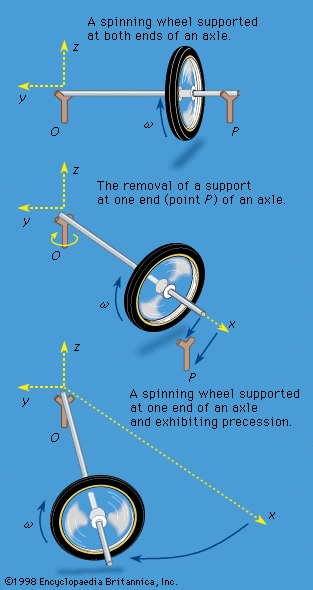
Illustration of gyroscope, Encyclopaedia Britannica (click image)
Precession seems to obey a form of the "right hand rule" for torque, which is also associated with electromagnetism, where it determines the magnetic field (curled fingers) around electric current (thumb) torque vector. (The same principle applies to spinning mass torque, where the thumb represents torque, and curled fingers are in direction of spin.) We know that gyroscopic torque vectors are powerful, as we use them successfully in balancing monorails, or stabilizing ships, aircraft auto-pilot, or in space aboard spacecraft. And though we learned to use this vector force pragmatically, are we truly understanding where it actually comes from? It is no longer accepted as being caused by spinning electrons, or particles, within the gyroscope mass, but a better explanation (other than mathematically descriptive) does not fully satisfy at this point, as found from various sources in physics.
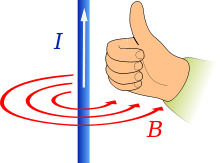
Right hand rule (article in image)

Precession of spinning wheel - Hyperphysics (click image for video)

Bicycle wheel conserving angular momentum by turning in direction of torque (video in image)
Note: how gravity force, offset by string's force holding up axle, converts conservation of angular momentum into precessional motion.
Questions: If the torqued bicycle axle is then held rigid, but resistance (pressed against) is applied against direction of precession, does the wheel 'spin up'? And if precession is accelerated (pulled), while axis rigid, does wheel 'spin down'?.. if angular momentum is conserved. Could some variance of this be happening to distant spacecraft spin up/down on their journeys through space?
But note how Prof. Lewin, MIT, shows the importance of mass-centered, as opposed to distributed at circumference, in this demo video lecture (50 min), how the hollow cylinder will lose downhill race to a solid one, for simple mathematical reasons. Later in the video, when that torque mass is applied to a spinning bicycle wheel (by moving the axle), the resulting precession turns the spinning wheel (and professor) in the direction of torque, which is 'counterintuitive' but perfectly valid physics. But why does this happen? Is conservation of angular momentum all it is? And if so, why does this 'conservation' exist in the first place?
When we observe the remarkable stability of a suspended bicycle wheel exhibiting torque precession, it feels 'counterintuitive' to be so solidly suspended on a string, watching it spin and precess accordingly, per conservation of angular momentum. However, to explain angular momentum precession because of 'angular momentum' precession, no matter how well described, is still circular. We need a better idea. Why is spin so stable, and conserves angular momentum?
This may have to take us back a few pages of Humancafe forum posts, where three factors of mass, inertia, and spin were discussed earlier, though unconventional:
1. Mass: http://www.humancafe.com/discus/messages/6/17.html#POST321
(Mass is gravitation equivalence)
http://www.humancafe.com/discus/messages/6/17.html#POST323
(How 'volume times acceleration' is mass)
http://www.humancafe.com/discus/messages/70/166.html
(Mass as a small 'remainder' function of Energy - per Axiomatic Equation)
2. Inertia: http://www.humancafe.com/discus/messages/88/475.html#POST4689
(How e.m. energy modifies 'inertial mass' in the atom)
http://www.humancafe.com/discus/messages/88/97.html#POST3366
(Rotating sphere inertia produces 'minute electromagnetic field, per Rindler)
3. Spin: http://www.humancafe.com/discus/messages/1177/1977.html?1309625395#POST5520
(Spin as evidence of super-small-micro black hole)
So let's put these together, per the Axiomatic Equation©: If 'mass' can be thought of as atomic-strong-force modified by electromagnetic energy into a 'remainder' force of gravity G, which by the Equivalence Principle defines inertial-mass, and this mass is measured from the mass-center of any massive object; then 'inertia' is a product of how this mass is modified by e.m. energy, and such inertial-mass is 'conserved' in angular momentum of any spin body; then the spin evident of such bodies is a function of some cancelation of all e.m. energy on a point, its axis, so a very small micro-black-hole results, though this is unmeasurable. In short, inertial mass put into high spin produces a surprisingly robust vector force. Could this be a usable, accelerative force of motion? The secret is what happens in micro-black hole dynamics inside the axis of spin?... We don't know.
Is this perhaps not a new way to view what is happening in gyroscopic physics, especially as it applies to 'precession' when gravity acts upon a horizontal axis of the spinning body? But if this were true, it would mean the micro-micro-black hole at center of spinning mass (unmeasurable, virtual) has some unique properties, that it can exert such a robust force on the spinning body as to give it precessional movement. And that in itself can be significant, as it is not an 'unmeasurable' effect, but quite readily visible and measurable at the macro-level. In effect, if true, the precession of gyroscopes may betray some as yet unknown quality of that 'micro-black hole' resultant from spin, and one if it were better understood could be used beyond the current applications of gyroscopes. What else can a gyroscope be made to do? Can it somehow be tamed into producing motion, for example, beyond the precessional rotation? And if so, then could there be a 'torque' (vector) V-force application for it? Loony toons idea? Perhaps it is for now...
Also see fun video shorts on gyro demos: The Eric Laithwaite's 1974 Lecture
"The Engineer Through the Looking Glass" - Can 'lateral' thinking invent new ideas in science?
What is 'failure' anyway? See Edward de Bono short video (1 min).
Ivan |
    
Why 'Right Hand Rule'?
| | Posted on Saturday, August 06, 2011 - 02:34 pm: | |
Why the 'right hand rule' in spin and torque?
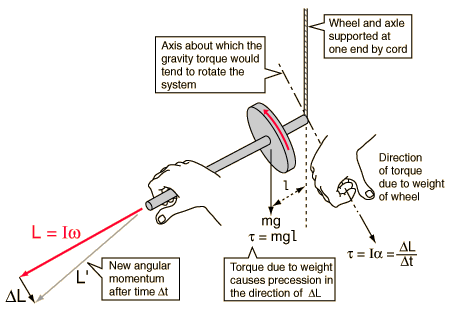
Precession Torque (interactive- Hyperphysics page)
It's Precession Torque that is most puzzling to me: Why at right angle? (And why that right angle as opposed to the other way?)
Only thing I can think of is that it is related to Right Hand Rule of Torque as a vector of tangential angular velocity.
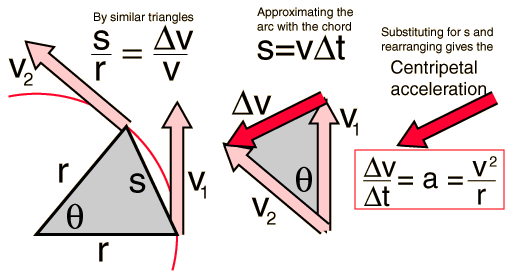
Centripetal Acceleration (interactive)
But not convincing enough… There must be something else that determines why the right hand rule exists in the first place. Perhaps from how electro-magnetism's 'right hand rule' torque?
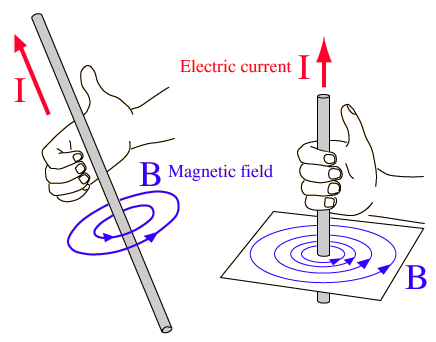 (interactive) (interactive)
'Virtual' black-hole… anyone? 
*** *** ***
These are mere speculative musings, but something goes on here:
The Math for Angular Momentum and Gyroscopic "Modified Vector Dynamic"©. (Patent Pending)
[Note: The First Tier math (S1) is straightforward as applied using standard angular momentum physics and gyros specs. The Second Tier (S2) makes some rough assumptions that will need verification in lab experiments, but lead to interesting prospects should it prove correct. -IDA]
First Tier: Lateral precession.
Starting with delta L angular momentum, where delta L = I x w,
spin frequency f = 200 rev per second
mass = 0.345 kg
radius = 0.0265 m
tangential velocity V = 2pi r x 200 = 0.1664 x 200 = 33.28 m/s
angular velocity w = V/r = 33.28 m/s /0.0265 m = 1256 m/s
moment of inertia I = mr^2 = 0.345 kg x 0.0007 m^2 = 0.00024 kg.m^2
…therefore, solving for delta L = Iw = 0.00024 kg.m^2 x 1256 rads/s = 0.3014 rads/s kg.m^2
Now we can solve for Torque † = amr^2 = I x a, where a is centripetal (angular) acceleration a = V^2/r, so that,
solving for (radial) angular acceleration: a_R = w^2 x r = 1256^2 m^2/s^2 x 0.0265 m= 1577536 x 0.0265 = 41804.7 m/s^2
… then torque † = 0.00024 kg.m^2 x 41804.7 m/s^2= (canceling out m/s ?) = 10.03 rads/s m^2.kg/s
(Note: For gyro rotor alone, weight is m = ~ 150 grams = 0.15 kg, to that with gravity acting on shaft, d = 0.06 m, of horizontal gyro g = 9.8 m/s^2, so that gravitational force acting on gyro is: 0.15 kg * 09.8 m/s^2 = 1.47 kg.m/s^2; so for half shaft length 1/2 d we have downward -transfered 90 deg to lateral- torque †_g = 0.03 m * 1.47 N = 0.044 kg.m^2/s for 1 second. Of course, the whole exercise below would be readjusted for this torque, if so.)
______________________________________________________
Second Tier: 'Vertical' precession (perpendicular to lateral above, induced by added spin to gyros platform).
Now, to solve for same with 3 gyros as above on a 8 cm radius base spinning 1 rev/sec:
delta L/† = Iw/Ia = 0.3014 rads/s kg.m^2 / 10.03 rads/s m^2.kg/s = 0.0301 kg^2.m^4/s^2 = angular momentum' = 0.0301 m^2.kg/s
....DELETED inconclusive...
[Postscript: MOVED G-force Note: It is not 'spin' that is the operative factor here, but rather the transfer of 'acceleration' that moves the apparatus along the axis. Spin merely transfers the gyroscopic effect, but added electrical induced acceleration pulses convert from radial to linear motion along the axis, as subsequent MOVED G tests showed, with 'kicks' of kinetic energy.
Also see: Why MOVED G works?
IDA |
    
Torus spec
| | Posted on Tuesday, August 09, 2011 - 02:50 am: | |
Torus Physics.
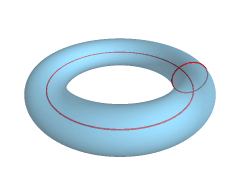 (interactive) (interactive)
Torus 'degenerating' into a sphere
Per Wiki"
quote:"In geometry, a torus (pl. tori) is, generally speaking, a doughnut-shaped object. More precisely, it is a surface of revolution generated by revolving a circle in three dimensional space about an axis coplanar with the circle."
Revolving a circle in three dimensional space is what was described earlier in the math for 'vertical' precession above. The inverse of a (degenerated) sphere could be made to represent a torus, if the energy contained within the sphere is made to revolve in three dimensional space. One way to do this is to form a self-gravitating rotating plasma, with a (hypothesized) virtual black-hole at its center. However, this is not referenced anywhere to be found, so must be treated as highly hypothetical, even speculative, physics. Therefore, the earlier reference (above) to rotating plasma may be clue to where this needs to go. Perhaps access to a competent (unbiased) laboratory could yield results to study this further.
Questions: 1. has this been successfully simulated in a laboratory, and 2. what are the energy parameters associated if so?
This line of research could yield interesting surprises, IMO. For example, could a 'torus' like MOVED energy described above cause to envelope the who craft so all parts within move as one inertial mass? This could prove indispensable to very fast acceleration, far in excess possible today with 'push' acceleration limited to a top 9 Gs, where the Gs may be virtually limitless. Imagine acceleration no more felt than at constant velocity! |
    
Nobel prize to...
| | Posted on Thursday, October 06, 2011 - 11:52 am: | |
Surprise! The "Expanding universe" gets a Nobel prize.
 (interactive) (interactive)
Adam Riess et al get Nobel prize in physics
"Dark energy is supposed to be the inherent energy of space-time, something we still don't fully understand. It would have been odd to receive a prize for having discovered a mystery…
Absolutely. The acceleration of the universe is the smoking gun of something. It may well be dark energy, but there are other possibilities. It could be that gravity on larger scales doesn't operate the way we think it does. The cleanest thing we can say is that the universe's expansion is accelerating and that's a great surprise."
Indeed, there may be "gravity on larger scales" (and more) at work in this "expanding" universe… if truth be told. Is this where we are going in 100 years? Space Travel in the 22nd Century
IDA |
    
Tesla coil ,,, reverse?
| | Posted on Monday, October 10, 2011 - 01:32 pm: | |
Tesla coil… in reverse?
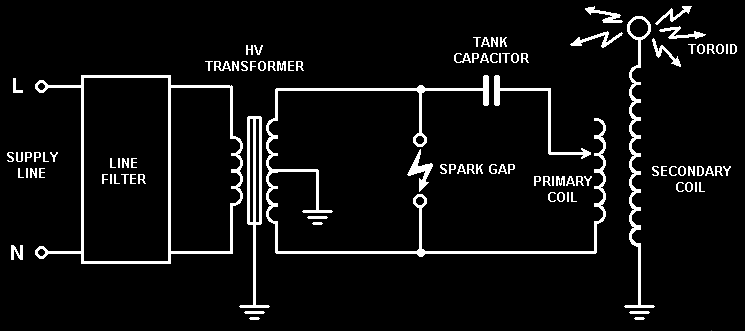
Tesla coil diagram (interactive)
There are a lot of junk videos on You Tube claiming 'free energy' and perpetual motion machines. It's all bunk, you don't get nothin' for nothin'. But every once in a while, there is a presentation that may have some glimmer of possibility. Once such video is Tesla's Little Secret:
See http://www.youtube.com/watch?v=o7NdxnjetSw&feature=related
From Tesla's Little Secret video:
quote:A video based around Nicola Tesla's Tuned Coil. While pondering the basic circuit diagram I thought maybe the electronics were being used backwards ...if we reverse the circuit we could capture radiant energy from the atmosphere and use it as a source of power. Perhaps this is what Tesla intended in the first place? Tesla produced a paper talking about his vision for the future including a gravity shield, anti-gravity flying machines, The Magnifying Transmitter and other inventive technology. While Tesla had some scientific genius is without doubt although reading his paper I find some of his deeper beliefs about life, society, goverments and human sentience perhaps bringing about some of the very things he was trying to prevent? "Nikola Tesla is the true unsung prophet of the electronic age; without whom our radio, auto ignition, telephone, alternating current power generation and transmission, radio and television would all have been impossible. Yet his life and times have vanished largely from public access. This autobiography is released to remedy this situation."
I don't hold much stock in such (conspiratorial) claims that electricity can be gotten from the air… If so, why isn't it being done? But this potential technology may have future applications in space travel where electromagnetic energy is scraped from ambient space to recharge on board capacitors while in flight. … A possibility that would be most useful, if so.
My Inventions: The Autobiography of Nikola Tesla
Also see Space Tether Experiment |
    
Something about gravity...
| | Posted on Monday, October 17, 2011 - 10:26 pm: | |
Something about 'gravity waves'…
Is this for real? Can they really be used for propulsion?… I suspect not.
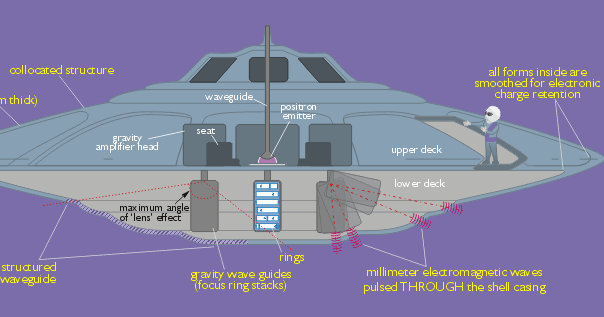
Lazar UFO (interactive - click image)
Also see: http://www.gravitywarpdrive.com/Gravity_Generator.htm and many other similar descriptions.
Hate to throw cold water on the party, but lot of this is wishful thinking, not real science.
Curious about the diagram's "all forms inside are smoothed for electronic charge retention" part. Could this be for other reasons, such as the electromagnetic ionization taking place from the plasma activated propulsion engines? The whole craft, except for a 'Faraday cage' over the crew cabin and electronics, would glow with plasma, which is a natural 'lubricant' for the craft's hyper-fast travel through a medium, such as air or water. (There might also be another spin-off, where the inertia of the craft is reduced by such hyper-plasma activity throughout the craft.) But those rounded corners inside the alleged craft may be nothing more than a way to reduce spark-arcing from all that ionized plasma flowing around the ship (except in Faraday-box enclosure). Plasma is both useful and unwanted as product and by-product. (The rounded corners and struts may also be the most efficient way to make shape strongest from their lightest weight materials.) Though this may be speculation, plasma glow for Alien spacecraft seems a natural phenomenon.
The truth may turn out simpler than we think. Also see: MOVED G-force motor Patent
Also see: Why UFOs glow with plasma |
    
Strange Dark Matter
| | Posted on Monday, October 24, 2011 - 12:37 pm: | |
In the 'dark' about Dark Matter?
 (interactive) (interactive)
Dark Matter Gets Darker: New Measurements Confound Scientists - Space.com
Not if it's much higher G gravity 'constant' than measured here. 
Strange? Dark Matter is everywhere.
_________________________________________________________________________
Something just in, Nearby Dark Matter Mysteriously Missing around the Sun. (Space.com, April 2012)
Well, no wonder, if gravity-G is inversely proportional to hot star energy. The nearer the Sun, the weaker the G. This is just how it is, as per the Strangeness of variable-G gravity. MOND is interesting, but in and of itself does not explain.
Also see: Why Dark Matter 'appears' non-baryonic |
    
Something about light and time
| | Posted on Monday, December 19, 2011 - 03:21 pm: | |
Something about light and time…
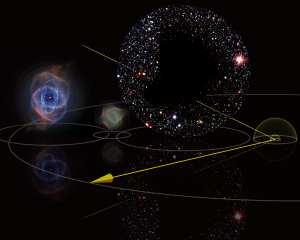 (interactive) (interactive)
Light year dimensions of space-time
This may seem a stretch, but think of light as a stretched 'bungy' cord, where the photons arriving now are still connected to their source of origin, no matter how far back in time, nor great the distance. (Implied is that though lightwaves in space travel at velocity c, the information held along the whole wave is simultaneously available throughout its length.) Now, why is this imagery interesting? Because all along that stretched light is information stored within the strand, so anywhere along its time-distance is the original electromagnetic information from the point of origin.
This is a strange way to look at it, but the 'information' stored in a band of light is perhaps retrievable in some way not yet tried: Can we radically blueshift the line-of-sight light-electromagnetic waves to a zero-point (ideally), so the stored information is nearly instantly accessible to us? After all, in Special Relativity, the dimension of Time is merely a redshift-blueshift phenomenon, so in theory compressing 'time' into a zero-point, to mimic entanglement, should be doable. And if so, then the severely blueshifted signal would contain in it information at the source in 'real' time, so communications can be almost 'instantaneous', rather than at the relatively slow lightspeed =c. If light is interconnected throughout the distance of its line of sight range, like a stretched signal over time, then why not 'compress' it into its ultimate blueshift zero-point and 'read' its distant message in real-Time? Wouldn't that make interstellar communications decodable now, FTL rather than what sent light years away took years to get here? Imagine, talking to Aliens in 'real time'?! … Maybe that's how they do it?. We just don't know how to... but it may be possible.
Imagine radio communications to our distant Pluto space probe New Horizons in minutes rather than now latency of hours… and maybe strengthen the signal by collapsing in 'real Time'.
…Whacky idea? This may be related: Discovery News - X-Rays: Next-Gen Way to Travel and Talk in Space?
Also see: Quantum Entanglement
Quantum Physicists Doubled the Information Speed Limit of the Universe - Space.com
Also see, dissenting view: Why Gravitational Waves are Nonsense
LIGO gravity waves |
    
Gravity Superhighway
| | Posted on Monday, January 09, 2012 - 08:35 am: | |
GRAVITY SUPERHIGHWAYS
Imagine if all of space is really made of background gravity, in varying degrees of intensity. And contrary to today's belief that gravity G is a universal constant, it rather is as described by the concept of G variability expressed by the Axiomatic equation. And if so, the rather weak G in Earth's region expands to an equivalent space background gravity G that is some 50,000 times greater in interstellar space, and perhaps 5 orders of magnitude greater than here in intergalactic space. The advantage to this variable-G is that while its use to propell space craft with MOVED G-force will accelerate it to subliminal speeds in our solar system, it will accelerate it to superliminal speeds in interstellar space. Velocity achieved through constant high powered G acceleration may reach Coulomb's constant times G dimensions here (Newton's G), but it could reach 50,000 times that velocity in interstellar/intergalactic space, or more. But wait... there is more!
Sci-fi adventures like Star Trek has them suddenly go into "hyperspace" and disappear in a burst of light only to flash reappear thousands of distant lightyears away. Well, would it be too bold to suggest, based on principle of 'zero point' wavelength collapse, and superliminal interstellar G travel, that such a 'flash' transport could be possible, only if at the receiving destination is broadcast a "tractor beam" to make this sudden-virtual acceleration possible. Once the starship enters the tractor beam and accelerates to near light speed, it would then make the jump into 'hyperspace' by collapsing (by superblueshifting) the beam so the craft "jumps" in space as if it were pure energy multiplied by blueshift into superfast energy. Err.. Sorry Einstein, we're leaving the 19th century for the 23rd... Imagine traveling at the Plank scale in "collapsing" space at hypervelocities to distant stars. Then more intense at the Compton wavelength, viz. lambda=10x-42m, and you compress plasma drive into near zero-point blueshift... and ... Woooosh!!
Only problem is they over there must 'invite' you with their tractor beam, to make this work. No invitation? Sorry, no go. Better behave, 'be nice' protocol, if we want to travel to other worlds. 
|
    
Test neutrino redshift?
| | Posted on Saturday, February 25, 2012 - 04:22 pm: | |
Can neutrinos be used to test for BBT universe 'expansion'?
 (interactive link to article) (interactive link to article)
Astrophile: The relativity-testing supernova next door - NewScientist
Wonder if the neutrinos arriving a few minutes ahead of measured light were also 'redshifted' per the Big Bang expanding universe hypothesis? That would be a valid test, since neutrinos do not interact with gravitational mass, so not affected by gravitational variance. Hence, if 'expansion redshift' is from gravitational (higher G in deep intergalactic space), then neutrinos are not redshifted. But if universe truly is expanding, then neutrinos would show redshift likewise.
Valid test?
___________________________________________________________________________
This is only related, but worth pursuing, ultimately a new form of digital communications.
ET, phone home, on your neutrino phone. (The Economist, March 17, 2012)
Maybe this is still early, but ultimately neutron-neutrino communications will be used, once ET contact is established, in real time. |
    
Mars and Venus related?
| | Posted on Thursday, May 31, 2012 - 11:55 pm: | |
Are Mars and Venus related?
  (interactive) (interactive)
Mars carbon dioxide ~95%; Venus carbon dioxide ~96%, per their atmospheric composition
This is a curiosity only, but is there some relationship between Mars and Venus in terms of their largely carbon dioxide (~95% to 96%) atmospheres?
We know carbon dioxide density in Earth's atmosphere is ~0.001977 grams per cc, with a molar mass of 47.7 g/mol.
It has been noted that both Mars and Venus have similar molar mass:
Mars = ~43.3 g/mol, Venus = ~ 42.9 g/mol
So why are these two planets with such totally different sizes and gravitational parameters similar in terms of their carbon dioxide atmospheres? *
If you factor in "variable-G" parameters, it almost begins to make sense. In terms of CO2 density, using Earth's CO2 density of 0.001977 g/cc value, and multiplying it by Mars's implied higher G (Mars is less dense, farther from Sun in higher G, lighter molecules can gather), of about 1.52G vs Earth's (per Axiomatic Eq., 2.4), you get 0.001977 g/cc x 1.52G = 0.003005 g/cc G.
By the same token, Venus's G is about 0.72 of Earth's, so 0.001977 g/cc divided (Venus being closer to the Sun is 'denser' by this amount, like Mercury, where closer to Sun and lighter-G means greater planet density - only heavier molecules can gather in lower G) by 0.72 G = 0.002736 g/cc G. So both are close. But stranger still are their molecular weight in moles: Viz, Mars's CO2 is ~43.34 g/mol, while Venus's is ~ 42.9 g/mol.
If this is true, then is it surprising both planets, thought totally different from one another in terms of size and gravity should render similar atmospheric CO2 density parameters? And to boot, they both have about the same level of CO2 concentrations in their atmospheres! Is this also something related to a "variable G" phenomenon? It does not prove anything, and perhaps oversimplified, since it ignores temperature and height of atmospheric columns, it certainly is "curious" in some whacky way. Strange coincidence?
*(We might also consider Venus vs Earth’s atmospheric composition, vis-a-vis the variable-G: Earth’s atmosphere is largely nitrogen and oxygen, with lesser amounts of carbon dioxide; whereas Venus is largely carbon dioxide. When comparing their densities it’s apparent that carbon dioxide has highest density, followed by oxygen and nitrogen’s lower densities. In a lighter G orbit, Venus best gathers heavier, denser gases, hence CO2, whereas higher G will gather lighter gases, hence nitrogen oxygen mix. On Mars, with lighter G than Earth and Venus, the high CO2 concentration is ‘favored’ because the planet is smaller than Earth or Venus, so must work harder to maintain it’s atmosphere for its small size. On Pluto, which has much higher G, and the planetoid smaller than our Moon, there is a surprisingly high atmosphere!)
Worth thinking about... |
    
Mars live panorama
| | Posted on Wednesday, February 13, 2013 - 03:17 pm: | |
Stand on Mars Next to the Curiosity Rover With This Incredible Panorama

Mars panorama (interactive) - Curiosity Mars Rover - click image for article and panorama scanning
Almost live webcam 
Stunning 4 min. video of fly through on Mars: Mars' Grander Canyon - Herb's Chasm (best on full screen)
Also see: Mars bio-blueberries?
Martian Skies and Victoria Crater, Opportunity
Just some personal observations in scanning Martian landscape:
1. Soil appears to be like tiny granular marbles, visible in high + resolution.
2. Broken rocks have sharp edges, not common to 'water' environments, more like dry deserts.
3. What's 'hiding' under the rock ledges?.. more bio-blueberries?
4. Martian sky looks dusty pale, but Sun is clearly visible.
5. Distant dunes and mesas look like Monument Valley on Earth, may be water eroded, or merely sand blown.
It's fascinating spending some time with this great NASA panorama of Mars, kind of like hiking in a dry desert, hauntingly beautiful. |
    
How 'big' Big Bang?
| | Posted on Thursday, March 21, 2013 - 02:07 pm: | |
Big Bang 'explained' by cosmology...
 (interactive - Space.com article) (interactive - Space.com article)
Here's the skinny on what happened from 13.82 billion years ago to now...
Contrast that with earlier post on Mass of the Universe and you can see these two worlds are universes apart. But the above infographic makes a good story to entertain mythology of the Universe's 'Creation' as mathematically envisioned in a post-Einstein cabala of popular CMB logic. But is it true? The first three segments of 0.000378 billion years, from Big Bang to Recombination, makes it doubtful.
But they like the story...  Loony toons, and the more they'll look, the more they'll find! Loony toons, and the more they'll look, the more they'll find!
Also see: Discovery News: Is The Universe Expanding Or Just Getting Heavier?
quote:Now Christof Wetterich, a theoretical physicist at the University of Heidelberg in Germany, has floated a radical new theory. He theorizes that the expansion of space is an illusion; the universe isn’t going anywhere and, in fact, may be contracting. The spectral redshift is not due to the expansion of space like stretching a rubber sheet, but a slow and steady increase in the mass of the universe. ...
Not as a variable-G universe explains it, but sort of in that direction, except the 'heavier mass' is merely higher G interstellar space. ... Not there yet.
Addendum:
According to the Cosmological Principle the universe is homogeneous and isotropic, so when we look in any direction its structure appears the same in all directions, as does its distribution of mass. But if we think about it, shouldn't there be some discrepancies if, and only if, we are not at its absolute center? So if the universe is some 13.8 billion years old after the Big Bang, and if Earth is some 5 billion years old since the accretion disk around our Sun formed the planet, then there should be some anisotropic and non-homogeneous observations possible. After all, if we are not at the absolute center of the universe, and we came into existence when it was already a fair size, some 8.8 billion years after creation, then looking in one direction should reveal less total mass than in its opposite direction; likewise, the Cosmic Microwave Background should appear more distant one way, but closer the other. In fact, the CMB (what is the origin background of the universe, its physical outer limits, in effect) should be more redshifted on the more distant side (traveling way from us due to expanding space) and less redshifted on the less distant, unless we were born exactly in the middle, unlikely (challeging the definition of 'isotropic' universe). But none if this is observed, which puts us dead center, and which makes us suspiciously terra centric, if so. So we are once more posed with a Copernican dilemma, that Earth is once more the center of the universe, which is unlikely. This begs the question, did the Big Bang actually occur, or is it the product of a fine Einsteinian, Lemaitreian fiction, where the math of General Relativity's cosmological constant happens to match the (observed) Hubble Doppler space expansion, and what fits handily into Fr. Lemaitre's Cosmic Egg creation cosmology? It would appear so, unless the distant cosmic light shift is from other than space expansion, making the fabled Big Bang origin of the universe rather suspect. Rather, beyond the distance where is the CMB, light is so stretched the universe remains dark to observations, so validates Olbers paradox.
Also see: MOND Revisited - why it is valid
When the biggest numbers don’t add up - BBC: Audio (Universe ‘expanding’ faster than thought)
Some Big Bang, modern Cosmology peculiarities |
    
Where have neutrinos gone?
| | Posted on Friday, April 05, 2013 - 01:05 pm: | |
Where have all the Neutrinos gone?
 (interactive: Radioactive Decay Predicts Solar Storms) (interactive: Radioactive Decay Predicts Solar Storms)
Model of solar neutrino event -credits: LBL Research Review
Neutrinos first theorized by Wolfgang Pauli (1930) were confirmed to exist positively in 1956, and reconfirmed in numerous detector experiments since. Though they remain mysterious, certain things are known about them. We know they are produced by radioactive beta decay (neutron decay conversion into proton gives off electron and neutrino), they come in three flavors - electron, muon and tau - (possibly four), that they may have miniscule mass (so affected by gravity), that they are charge neutral (mostly), they pass through matter effortlessly (except for rare direct hits with protons - how they are detected), neutrinos have left spin (antineutrinos have right spin), and also they can change in flavor (over distance). What is still open is whether neutrinos decay, whether antineutrinos are generated by 'dark matter' annihilation (antineutrinos), and whether they travel at the speed of light (proved later that faster-than-light neutrino was anomalous) or just short of c (if they have mass). The newly launched (2010) Ice Cube South Pole neutrino detector is working on resolving some unknown issues (where are they?); their experimental goals are Point source of high energy neutrinos, Gamma ray bursts coincident with neutrinos, Indirect dark matter searches, and Neutrino oscillations, amongst others such as String theory and Galactic supernovae research. At this time the search continues, which makes it a very exciting branch of nuclear physics and astronomy. If neutrinos (and antineutrinos) could be detected within better parameters, they then can act in astronomical observations more efficiently than photon energy, and with less impediment to visibility due to their 'pass through' characteristics.
There appear to be two main sources of neutrinos (and antineutrinos implicit): solar production from proton-proton chain reactions, what powers the Sun; and from radioactive beta decay due to nuclear weak force interaction. However, these two processes produce different types of neutrinos, so it complicates the simple picture of neutrino and antineutrino production. Nuclear transformation of neutron to proton (or proton to neutron), have the effect of releasing neutrinos; free neutron decaying into proton will release an electron and antineutrino, for example. This makes sense, as a neutron is essentially a (positive) proton 'neutralized' by (negative) electron. The reverse, however, of proton to neutron conversion is more problematic, as this should be 'absorbing' an electron, though the neutrino is again released. The second puzzle is why do neutrinos and antineutrinos exit in any particular directions? If they are charge neutral, then any possible direction could result, but why does it 'choose' to go one way rather than the other? In light production, the radiation is spherical, so it radiates in all directions if unimpeded. But neutrinos seem to favor only one direction, where they then zoom off at near light speed. Why? Or perhaps they do same as light, but only detected as being from a particular origin as an artefact of the detection process? If so, then neutrinos would shoot off in all directions simultaneously, like light, but unlike light they would be virtually unimpeded by material obstacles, since they do not interact with matter or magnetic forces. Puzzling...?
The third source of neutrino production is from supernovae, which had been proven in the Supernova 1987A discovery. Though as to why this phenomenon produces neutrinos may still be a mystery, it proved neutrinos have non-zero mass. The current theory is that neutrinos are released as stars go supernova and collapse into high density neutron stars, so the formation of neutrons from proton-electron merger releases neutrinos. This is in a sense similar idea to 'dark matter' annihilation, where DM 'particles' collide with their counter-particles they release neutrinos. Results of ISS (AMS-02) space laboratory at this point are still inconclusive, however. If the universe is a non-constant gravity G, then this annihilation may be nothing more than very high G (~5 orders of magnitude higher than here) in deep space forcing proton-proton mergers, which then release neutrinos. We cannot see them, however, because (hypothetically) of high-G photoelectric effect, so no light is released during such collisions. But neutrinos and antineutrinos get released, if so. Puzzling…?
Then there is the question of where do all these unimpeded neutrinos go? Once they are generated from various production sources, they travel indefinitely since they barely interact with matter or electromagnetic forces of the universe. If there was a Big Bang neutrino production scenario, then all those produced neutrinos would still be traveling… But where to? Are they now beyond the 13.82 billion year boundary? More interesting would be to 'image' neutrinos streaming in from the borders of infinite space and see what that looks like, if it were possible, and perhaps solve the riddle of Olbers' paradox of where have all the relic cosmic background neutrinos gone? They should be everywhere!
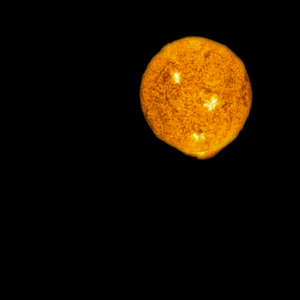
Olber's paradox - neutrinos?
Puzzling… Of course, if the universe is truly infinite, then they are coming from everywhere going everywhere... Now, that is puzzling! |
    
Standard Model deviant
| | Posted on Friday, July 26, 2013 - 02:12 pm: | |
Why Standard Model is incomplete - a deviant alternative?
 (interactive) (interactive)
We know the Standard Model is incomplete, though it responds well to experimentation. The sticky wicket is Gravity, which simply refuses to play fair. So here is a speculative extreme idea, deviant to be sure, that may cast shadow on why Gravity and the Standard Model don't match.
quote:"James Maxwell took a big step toward this goal when he unified electricity and magnetism, and physicists now understand that at high energies the electromagnetic and weak forces are aspects of the same force." (Unsolved Mysteries - Grand Unified Theory)
At present, the soup of 'fundamental' particles consists of Strong force "gluons", Electromagnetic force "photons", and Weak force "bosons"; we leave out Gravity force for now as it does not fit in, since "gravitons" do not appear in any experimentation to date. So, aside from the Strong force found at atomic nucleus holding protons together, we are really left with Electromagnetic force and Weak force, both of which are photon-boson dependent, which includes not only electricity and magnetism but also the neutrino. So to simplify matters, we will leave out the Standard Model nomenclature for now, and look instead at its two 'related' fundamental forces: Electroweak force and Electromagnetism. Whereas electromagnetic force, which is charged, can interact over infinite distances, the electroweak force, also charged, can interact only within the atom. So let us start there, for a truly wacky tour of what happens in that atom.
 (interactive) (interactive)
Imagine that the atom made of the nuclear strong force is 'modified' by beta decay electroweak force, as a starter. But this electrodecay (both positron and electron) is already a 'byproduct' of the electromagnetic force acting externally on the atom. Why? Because the atom exists in a hot radiant ambience near a hot star, like our Sun. So the more hot energy this atom receives, the greater is the electromagnetic force bathing it (at all frequencies), and the 'weaker' the strong force acting on the nucleus. This weaker is the 'beta decay' factor, which modifies the remainder of the Strong force, in effect.
Now imagine, again wacky idea, that the nuclear strong force of the proton is a positive charge, which in turn is modified by the electromagnetic negative charge of the electron around it. Now further imagine that though both positive and negative appear to cancel, so atom is charge neutral (except plasma, which is positive atoms in negative electron soup), there is still a tiny remainder 'leaking' out of the atom that is not the positive charge of the proton nucleus, but instead is a tiny weak 'negative' force charge that manifests only in the aggregate of large mass. For example, the Earth is a planetary body, so its total aggregate charge should be negative, per this reasoning (though atmosphere is positive charged). Now also imagine that this tiny negative charge interacts with beta decay forces within the atom, so they balance out… except for gravity, of course. That 'leakage' of weak negative energy then interacts with a remainder force of the proton's strong force, which opens a dimensional 'door', if you will (think Bosonic String theory), into another force that leaks out of the atom, in the aggregate. And that force, tiny when close to a hot star, but great and powerful when in the cold stretches of interstellar space (where only hot plasmas and cold dust and gas exist), is the force that we know as Gravity. In short, given this imaginary scenario, gravity is an interactive force within the atomic nucleus, neutralized by electromagnetic energy received, further modified by the electroweak force, to manifest as aggregate negative charge and remainder gravity mass.
Leaning back from this, the atom appears both are leakage from the very powerful positive charged nucleus held together by the Strong force, which is in effect an extreme gravity force (think SMBH), where the remainders are weak negative charge and gravity, in the aggregate. Can this be measured in a lab? Probably, but both forces are extremely weak, so to find the aggregate negative charge of mass (think Fg/Fe= (-)8.1e-37, with electric force dominant over gravity, so slight negative bias)* will demand extremely fine measurements. And if this is found, then per the above reasoning, we may have found the pathway through which gravity leaks out of the atom, and what gives it inertial mass (per Equivalence). Therefore, where the electromagnetic energy around the atom gives it a tiny negative remainder force, that same energy leaves a tiny hole for the extreme gravity-strong force to leak out as the gravity we know. Strange indeed, but it kind of makes sense. And if so, then we are one step closer to unifying the three fundamental forces with inertial mass-gravity. Though gravity is charge neutral, inertial mass is not; it is 'negative' in the aggregate. Gravity is then nothing other than a (variable-G) 'deviant' remainder of the nuclear strong force. If so, no 'gravitons' need apply.
*(Note, if you divide Fg/Fe=8.1e-37 by electron mass =9.1e-31 kg, you get electron mass charge delta=~0.9e-6, which is approximately the Weak Force Coupling constant, for example.)
Of course, that still leaves out Dark Matter, but in a variable-G universe, that's another story.
IDA
See also: Smashing tea cups -LHC atom smashing
Gravity remainder of Strong force
Nuclear positive charge modified by electromagnetic energy |
    
How Sun works, novel idea
| | Posted on Sunday, February 23, 2014 - 02:12 pm: | |
How the Sun works - a radical novel idea
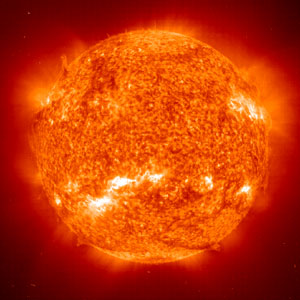
How the Sun works (click image for article)
This novel idea on how the Sun works and was formed is resultant from the alternative idea to modern Cosmology, that rather than Newton's gravity G being a universal constant, it is instead variable-G, where it increases inversely to the solar energy density where measured. So in deep interstellar space, far from any star energy, gravity-G becomes extreme, some five or six orders of magnitude greater that what is measured on Earth. The idea is further predicated by the concept that the Sun has a mini-black hole at its center: Solar Black Hole revisited, which is nearly six meters in diameter. This was further explored in: Something weird about the Sun's radius… It seems that per the Axiomatic Equation, numbers work out for the solar diameter to be approximately what it is, and that background gravity-G for where the Sun resides approximates the same deep space gravity hypothesized, viz. where G=~1.6E-5 m^3 kg^-1 s^-2. The Plasma physics of our Sun accounts for the pressure necessary to keep it from collapsing on itself. But there may be another factor that powers our local star, or any hot star, for which present physics had not accounted. It has to do with the Sun's mini-black hole.
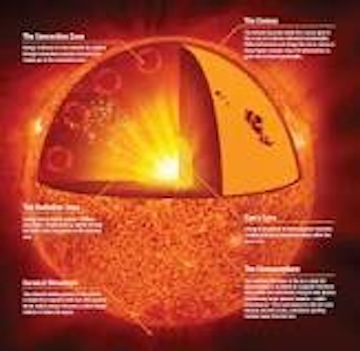
Current model of the Sun
The idea that the Proton is a micro-black-hole was explored briefly, where it is at the femtometer scale. This might lead to the idea that free hydrogen in space may be made of these protons, with electrons attached. Or they may be free protons without electrons, so are ions in hot (but diffuse) plasma ambient environment, out there in deep interstellar/intergalactic space where G is very great. If so, the high gravity-G pulls together these free protons, their mass per Equivalence being equally greater, to come into a fusion-able state that could reach critical mass and combust into a hot star. This would imply that the free hydrogen mass (and other light gas, like free helium) would condense into a highly solid mass with extreme gravity-G, so that within the solar mini-black-hole is contained the entire solar mass (viz. M=1.9E^+30 kg) tightly compacted within the ~6 meters of the solar mini-black-hole. This is an eccentric idea for certain, but it may explain how the solar hot plasma (viz. E=~3E^+24 Watts) composing the solar total mass is essentially very light gravitationally, as the near total mass of the Sun is concentrated in its black hole center. And if so, then the Sun's energy is not generated by nuclear fusion, but is another form of very great gravity-G effect fueling all the plasma exterior and electromagnetic forces at work on the Sun.
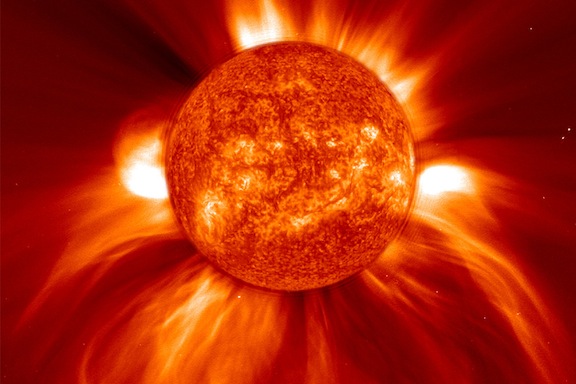
Sun is hot active
In effect, per this extreme hypothesis, the Sun is a large electromagnetic, hot plasma furnace fueled by the Strange physics of a large stellar body made of collapsed free hydrogen protons compacted into a mini-black-hole (some 4.5 billion years ago) surrounded by a hot photosphere that continues to throw off hot energy at all wavelengths, including visible light and ultraviolet, x-ray and gamma, and is gravitationally held together in its current dimensional parameters (viz. R_solar=6.957E+8 m) with all characteristics observed: sunspots, flares, interior convections, differential solar rotation, twisting of magnetic fields, radio waves, solar wind, neutrinos, etc. If a mini-solar black hole can generate all these, we may be on the threshold of a whole new world of physics. And if so, the idea that our local Sun, or any star, is a nuclear furnace may need to be revisited, along with the Big Bang theory, universal gravity-G constant, and the 'expanding' universe Cosmology, as they could all prove incomplete, or wrong.
IDA |
    
Pluto density anomaly
| | Posted on Sunday, August 17, 2014 - 01:47 pm: | |
Pluto density anomaly?
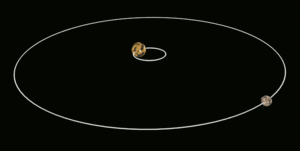
Pluto Charon orbits (interactive)
Do we really know Pluto's density, or are we best guessing?
Comparing our Moon's mass and density with Pluto, we have as follows:
Moon mass = 7.35e20 kg
Moon density = 3.34
Pluto mass = 1.305e20 kg
Pluto density = 2.03
Taking a ratio of mass, we get:
Moon/Pluto = 7.35e20/1.305e 20 = 5.632
Taking ratio of density, we get:
Moon/Pluto = 3.34/2.03 = 1.645
Now, if we 'think outside the box' and entertain what may appear absurd, we can take Moon and Pluto relative ratios to 'imagine' their relative masses and density as functions of each other, given the Moon is at about 1 AU and Pluto at ~30-49 AU. If, per Axiomatic Equation's variable-G hypothesis, their relative gravity 'constants' are 1G and ~30-49G, we can interrelate them as follows:
Pluto density times Moon/Pluto ratio = 2.03 x 5.632 = 11.43
which times density ratio = 11.43 x 1.645 = 18.8
Now, reversing this, we take Pluto density divided by mass ratio = 2.03/5.632 = 0.36
which then multiplied by density ratio = 0.36 x 1.645 = 0.593
This on the surface seems irrelevant, but how it might be interpreted, given outside-the-box thinking, is that Pluto's density in the prior is made 'equivalent' to the Moon's location, at 1 AU, by multiplying by its Moon/Pluto mass ratio; and then adjusting this by the density ratio; so it is 'as if' Pluto were in 1 AU orbit, but with 30-40 G mass equivalence: Viz. density = 18.8, as if it were more dense by equivalence, as adjusted.
Conversely, by dividing by Moon/Pluto mass ratio, and multiplying by density ratio, it is as if Pluto's density were measured here at 1 AU, which is what Pluto's density would be if it were taken with 1 AU values, but still in its ~30-49 AU orbit. Viz. density is much lower at only 0.593, as adjusted, which might represent Pluto's 'real' density (less dense than water, but more dense than snow).
This could be understood, thinking outside-the-box, to mean that Pluto's real density is very low, but if it were made equivalent to density here, it would be higher (per higher G), as adjusted.*
So now, let's take a leap of logic, and try something:
Let's take a ratio of Pluto's mass adjusted ratio and divide it by its density adjusted ratio:
18.8/0.593 = 31.7, which is relatively close to Pluto's G (if gravity 'constant' grows at 1 G per 1 AU), given Pluto is approximately ~32.6 AU in 2014: Viz. its current G is about 31.7 G, (vs. ~32.6 G) if so.
[Note: By happy coincidence, the Moon/Pluto mass/density ratio approximates the square root of its AU distance from the Sun, Viz. assuming Pluto's ~32 AU, taking the square is =5.66 (not so far off from earlier computed 5.63, which is square root of 31.7), so this could be a short hand formalism to estimate the relative mass density ratios of bodies. For example, per the above:
Set 1: 2.03 x 5.66 x 1.64 =18.84
Set 2: 2.03 / 5.66 x 1.64 =0.59
Which in effect, taking their density ratios becomes:
18.8/0.59= 31.86 G (pretty close to 31.7 G computed above)
Therefore, in effect, here is a simple shorthand method of calculating relative densities in a variable-G universe, per their relative AU cum G ratios as shown, if this is relevant as shown. By the same token, square root AU was used to balance planet spin ratios in order to bring orbits into relative unity, calculation short hand for planet energies at AU, or de facto Pioneer Anomaly, so not so strange.]
Are these ratios relevant, or just fantasy? Is the final result mere numeric coincidence? At this time we cannot know. But as the New Horizons probe approaches Pluto in 2015, let's watch for density anomalies. They may be there.... Perhaps a a Pluto Effect? It may also explain Pluto's unexpectedly high atmosphere.

Some craters on Pluto named, for features spotted by NASA New Horizons probe 2015
Addendum: There may be a short hand way to estimate Pluto's effective density, which is now at about 32 AU (~32 G) from our Sun, that could give us a real density for the mini-planet. If we take the square root of 32 (G), which gives a density of 5.66, we arrive at some proximity of what is Pluto's effective total density (if it were water, density of 1), which puts it at about the density of rock minerals (like cubic zirconium) though it is largely an ice ball, so would be adjusted downward. This would be a function of higher gravity-G, at about 32 G, of which its square root translates into a rock-like density, for the nitrogen and water ice of its composition, to act as if it were higher. (Viz., at Saturn's ~9 G the density ratio would be about 3, so water there would be three times as dense, about density of bromine, were it liquid.) Of course, this density would change depending on at what AU Pluto is in its orbit, so it would be maximum at aphelion, for example. But at this time this is merely a speculation, until we are able to effectively measure (with deep penetrating radar) Pluto's real density.
*(In all likelihood, Pluto's density is probably about the same as for any other body its size with similar composition, if the variable-G is factored in. For example, taking Pluto's light density of 0.59 gm/L and multiplying it by the 32G square root, viz., 5.66, then we arrive at about the same density of our Moon at 1G, which is 3.34 gm\L; but if divided by 1.64 ratio, we arrive at current Pluto density, viz., 2.03. The converse is also true, where the Moon's G equivalent density at Pluto's 32G, viz., 18.8, when divided by 5.66 ratio, yields 3.34, which is Moon density at 1G.)
IDA
Also see:
NASA New Horizons LORRI images of Pluto flyby
and Pluto and Charon in color
Pluto's Atmosphere Density Anomaly
(short story) Welterweight Pluto takes on Heavyweight Einstein |
    
Binary asteroid instabilities
| | Posted on Sunday, September 07, 2014 - 12:45 pm: | |
Binary asteroid high eccentricity orbit instability
 (interactive) (interactive)
MarcoPolo-R Mission - Sample return from a primitive Near-Earth Asteroid
There is scant evidence as to why binary asteroids with high eccentricity orbits exhibit chaotic orbital instabilities, and at present it is believed perturbations from a 'hypothesized' third body in their orbits may account for these instabilities.
Viz.: Stability of the orbit of a third body in binary asteroid systems
quote:The second indicator was the maximum eccentricity (ME), reached by an orbit during a given integration time. Orbits with higher eccentricity may become unstable more likely, due to close encounters, thus the ME is a good indicator of stability (Dvorak et al. 2003; Nagy et al. 2006).
...
4. Conclusions
The orbits with high eccentricity and large semi-major axes become unstable in every investigated systems within a short time interval. Outside the sphere of influence but inside the Hill sphere orbits can exist with high eccentricity. However, in this region the effect of the Sun becomes significant, consequently a model of the four-body problem should be used stability investigation. Gravitational capturing take place at high eccentric primary orbit, accordingly this mechanism cannot establish a long time stable bounded triplet. However the stable region extends to remarkably large values of the semi-major axes, therefore it is possible that a third body exists in these systems. These bodies might have been born by thermal YORP effect or a major impact.
There may be a simpler explanation, if variable-G is factored in, where G grows with distance from the Sun at about 1 G per 1 AU, whereby the orbital stability at perihelion may become unstable at aphelion, if the gravity G is weaker at prior but greater value at latter: gravity G defines asteroids' density, so it is less dense at perihelion but denser at aphelion, which affects their orbital stability. If so, then binary orbits should be wider at perihelion, orbit time slower, and narrower at aphelion, faster, per gravity G equivalence; anomalous G adjusted dynamics, which combined with asteroids' irregular shapes, may account for observed chaotic orbital behaviors. (Also see above: Pluto density anomaly.)
To my knowledge this had never been studied as such, but something to look for, if Newton's G is not a universal constant. Perhaps the 'third body' hypothesized is unnecessary, if gravity G is the variable?
Also to consider: Asteroid rings.
It came as a surprise that asteroid 10199 Chariklo should show rings around it. But in a variable-G universe, where Chariklo's orbit is at about 13 to 18 AU, there should be no surprise, as it inhabits a higher G environment, at about 13 to 18 G. For same reason we see rings for the outer planets, from Juputer to Pluto, having rings, the same could be predicted for any large body there, that rings of debris would form.
IDA
See also: Gravity, the perfect illusion |
    
New Spin on Planetary Spi
| | Posted on Monday, June 29, 2015 - 12:54 pm: | |
New Spin on Planetary Spin qua Internal planet Temperatures.
(Note: this is a continuation of earlier discussion on planetary spin as a function of black body temperatures showing parity between solar radiance received and orbit distance qua planet's black body, which proved inconclusive.)
There may be a much simpler way to consider the hypothesis that planetary interior heat drives planet rotation, as had been attempted in earlier explorations. Then we had attempted to compare some ratio between total planet orbital energy with black body temperatures, but this merely confirmed that there exists parity between the two, and it left us no closer to understanding the relationship between planet temperatures and spin. This new approach, albeit crude and speculative, shows some possible relationship when interior planet temperatures and rates of spin are considered. The hypothesis is based on the idea that interior heat in a spherical planetary body cancels on a point at its center, which generates a very small mini-black hole gravity, which in turn drives the planet's spin. This is in contrast to currently accepted theory that spin is caused by remaining primordial inertia momentum, so planets spin unimpeded by friction. However, this may be false, as planets have atmospheres, which would cause atmospheric drag on spin. It also fails to explain Venus' super spin atmosphere, which is anomalous. In fact, Venutian winds and atmospheric rotation is better explained as solar spin momentum transfer (or perhaps an artifact of its mini-black hole spin), which translates into atmospheric spin. With this in mind, there may be basis for considering whole body planet spin as a function of its interior mini-black hole spin vortex, which drives a continuous planet spin, and which is relative to the size of its black hole, itself a function of how hot the planet. This, of course, is a 'best guess' at best (other factors may be considered), since we do not know with certainty the planetary interior temps, same as we do not know whether spin is contingent on planetary mass. So for the sake of simplicity, planet mass here is ignored, assuming it cancels out as the interior heat is a factor of its mass size, and the ratios of internal heat to spin are calculated as simple ratios ignoring mass. Here is what a thumb sketch of these relationships looks like, but these are only guesses at this time.
(Temps taken from Planets' interior temperatures and magnetism, may not be exact)
Below is a simple relation of the planet's alleged interior heat compared to planet spin, where Venus is base Zero (it had virtually no spin) and Earth is base 'daily 24 hour spin'. The higher the ratio, the faster the spin.
By the numbers:
Mercury: ~2500C/5000=0.50 (very low spin, inconclusive as very close to Sun's heat where interior and exterior temps may be at some equivalence factors)
Venus interior temp: 5000C/5000=1 (base zero, virtually no spin)
Earth: 6000C/5000=1.2 (Earth's daily spin, viz.,
1.2 is equivalent to 24 hour planet spin)
Mars: ~4000C/5000=0.80 (nearly equals Earth's daily spin, at 1/0.8=1.25 vs actual 1.03 Earth days, but off the mark)
Jupiter : ~14000C/5000=2.8 (faster than Earth's daily spin, at 1/2.8=0.36 vs actual 0.415 Earth spin)
Saturn : ~12000C/5000=2.4 (faster than daily spin, at 1/2.4=0.42 vs actual 0.455 Earth spin)
Uranus & Neptune: ~8000C/5000=~1.6 (somewhat faster than daily spin, at 1/1.6=0.625 vs actual 0.718 and 0.673)
(Note: Jupiter interior heat radiates 1.6 to 3 times heat received from the Sun. Saturn probably 2 times as hot as Earth.)
Note, the earlier hypothesis considering background solar energy as a ratio of planet total orbit energy and solar flux has been dropped for these purposes, replaced with a new hypothesis that interior planet heat is against a background of space energy, in effect the temperature of the CMB as opposed to the solar energy at the planet's orbit. All this is on a 'best guess' basis, since we do not know planet heat with certainty. So the above is a very rough estimate of how planetary internal heat creates its mini-black hole, of which its natural spin drives the whole body into a perpetual planetary rotation, so an illustration only. The hypothesis at this time remains interesting and anecdotal, but unconfirmed.
IDA
Also see: Why do planets spin? |
    
Godel's theorem proves free will
| | Posted on Thursday, March 24, 2016 - 01:43 pm: | |
Does Godel's incompleteness theorem prove we have 'free will'?

This may be perhaps tongue-in-cheek, that Godel's incompleteness theorem can prove we have free will. In his famous theorem, it says mathematics cannot prove every mathematical proposition. In effect, per this theorem, some mathematical truths can never be proven true. ('Zero times infinity equals one' is one example that comes to mind, since we can infer that each number times its inverse progressively approaching infinity as its inverse approaches zero, the equality approaches one, but cannot be certain of this if infinity also incorporates all the infinitesimals greater than zero; so it remains 'incomplete'.) In a mathematical universe some truths may elude us, same as may be true of the real universe, where certain truths may be relative or illusive. For example, do we really know what we think we know? Or is the universe a self generated illusion, so we can never be sure we actually know what we think we observe? It might be a self imagined hologram we invented, a very convincing illusion, so nothing we know can with certainty be known, as it may only be our personal illusion of it. I am fairly certain I exist... but do you?
This takes us to another proposition, that our 'illusion' of certainty is itself an 'incompleteness theorem', such as proposed by Godel. What we think we see and understand is no more than our illusion of it. Now, if we project this uncertainty onto all reality, then we might say that reality itself is 'uncertain' of its reality, something like the uncertainty principle of the Quantum world, where observations are uncertain. But an illusion of an illusion of an illusion is an infinite regress, so in the end it is meaningless. Better its corollary, that the universe is an interrelated mathematical whole, to infinity, where it is a certainty in relation to itself. However, that leaves us with pre-determinism, which fails at infinity, as the universe is incomplete, per Godel's theorem. Therefore, though we can imagine an interrelated universe as totally deterministic, at infinity it is not. And that leaves our place in it as being non-deterministic, as its determinism is incomplete. In the end, that cheeky original statement, that Godel's theorem is proof of our 'free will' is complete, what fills the gap, because we as conscious beings must exercise free will to complete it.
In conclusion, though the universe is totally deterministic in its interrelated construction, why the laws of mathematics work in physics, it is merely statistically pre-deterministic at infinity, which includes our existence in it. Consequently, that 'incompleteness' at infinity, and this is true for all sentient beings, is what defaults to free choice that allows us to transcend pre-determinism; so per its internal construction, it is pre-determined that we exercise our free will, of necessity.
IDA
Also see: Do we have Free Will?
Cooperative Individualism |
    
Discussion: The Question
| | Posted on Sunday, March 05, 2017 - 01:31 pm: | |
Discussion Topic: The Question: Why is there something rather than nothing?
(This is material for possible discussions, should people find it interesting.)

Walking in nothingness
From the Platonic 5th century BCE, to post modern Existential Nihilism, the question of Nothingness has perplexed thinkers as to why there is something rather than nothing. The simple answer is that something is a negation of non-being, i.e., nothing. But what is Nothing? Therein lies the puzzle to Everything that is, that nothingness must be negated to find an answer.
If we imagine a universe that is infinitely inter-connected, a universe of absolute totality of everything, can we imagine the converse, a universe of absolutely nothing? (Mind, this is a mental exercise, a game of 'imagine', but it can be useful.) So imagine this (make believe) image that there is nothing, absolutely nothing. But in this nothingness now has been put the being of three randomly positioned (zero) points. There are three points in nothing, just hanging there in relation to one another. So no one point in nothing has any meaning, except in how it relates to the other two points in nothing. In effect, any point in nothingness has meaning only as it relates, or inter-connects, to the other two points. Therefore, all points are defined by their interrelationship with the other two points, or their (emergent) property as three points together. That is the new totality of nothing, where these three points are now everything.
Imagine further that this simple interrelationship (as shown with three points in nothing) now has the ability to span absolutely everything, all points from here to infinity, in real time (instantaneously, like a super giant computer), and geometrically in four dimensions (three dimensions plus time). So nothing can exist outside this infinity spanning existence of everything. (Mind, we are imagining this.) Now, if all things in nothingness are trapped within this infinitely interrelated web of everything, then something interesting emerges: "Nothing can be what and where it is except as the pressure of everything else has allowed it to be." Think about it a moment. This means every physical item, every being, property of existence, every event, even every person, is within this (Nihilistic) Nothingness exactly as an infinitely interrelated totality of Everything has allowed it to be. (Remember, we are imagining this, a kind of mind trip.) Everything is everything. So where does this go? Can it be a definition of universal reality? We are what we are, and where we are, exactly as the infinity pressure of universal interrelationship allowed us to be. (Remember, two plus one, that it is 'emergent' three.) Except that we also have free will. So this 'free will' is the other emergent factor that redefines our (imaginary) infinite interrelationship. In effect, therefore, what and where we are is contingent on our being in this emergent reality as the pressure of everything (to infinity, in real time) has allowed it to be, plus one, our free will.
So we perhaps do not exist in a vacuum of Nothing. Rather the converse, that we exist in the emergent pressure of Everything, to infinity. But what does that mean? Here is where we can default to discussion, because now there are questions that may not have been obvious before, where questions like The Question, may (not) have answers. But they should warrant discussion.
(Discuss)
Some points of possible discussion:
1. Can this imaginary idea of infinite interrelationship be a model for how the universe is self-organized?
2. What are the implications of an inter-connected reality for how we exist in it? Is our personal reality pre-determined?
3. Does such an infinitely interrelated reality have emergence, where the totality redefines itself in some evolutionary way, why we have life evolution?
4. Does 'free will' play a part in how our existence is affected by how we think and do, how we are in our lives? Does free will trump a predetermined universe?
5. Does each person have a personal identity definition within an infinitely interrelated universe, what defines for us Who we are?
6. If there is evolution of life, what is its purpose? Can it be a universal evolution of Consciousness in all living things, even on other worlds?
7. Does how we interact with each other, whether in good will or ill, have implications for how we manifest our lives, and the lives of others? Is our universe inter-active with us?
8. Is this imaginary scenario, that we are all inter-connected with a self defining, possibly evolving, Consciousness; can it possibly define our living being, our conscious reality?
9. Is the univetse a giant super computer?
The idea that everything is inter-connected in an infinite matrix of interrelationship, redefining itself in an emergent universe, has implications in how we make our world, in our works, our art and intellect, how we love, and what in effect makes our civilization. These are the questions open for group discussion: Is this why we have 'something rather than nothing' in our self-consciousness physical existence? Or perhaps all these interrelations cancel out to nothing, so nothing is affected, all being reduced to nihilistic nothingness? That is The Question.
IDA
For more discussions see: List of discussions |
    
Vortex spins
| | Posted on Saturday, November 11, 2017 - 04:33 am: | |
Why do opposite spin attract, while same spin repel?

Vortex
This may be explained with simple vortex dynamics. For example, while watching water whirlpools in the Tiber river, I noticed that same spin vortexes took longer to merge than opposite spin.
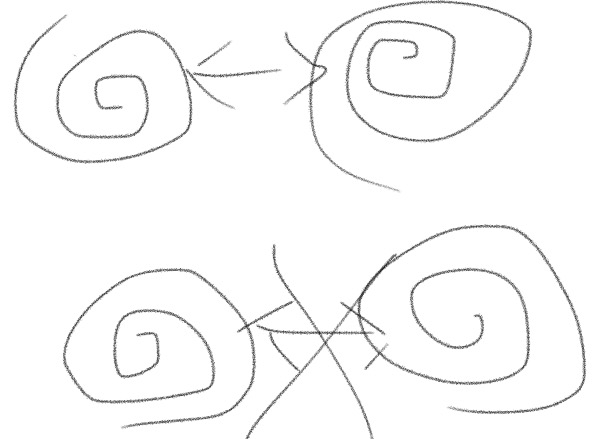
Vortex spins
Could this explain why opposite spins attract? In the electron, this spin phenomenon is known:
quote:Question: Why do electrons having opposite spins attract?
Answer: Electrons mostly repel each other due to having the same charge. Electrons with the same spin don't repel any more, but are not allowed to be in the same quantum state...
Electrons with opposite spins are already in different quantum states - being in different Sz eigenstates. So they can be in the same spatial state. This isn't attraction, but a lack apparent repulsion.
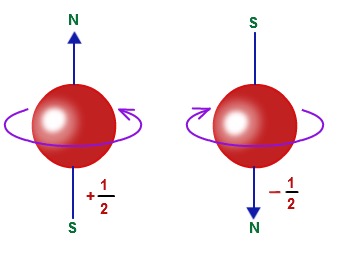
Could 'charge' be explained with spin? It could be that 'same charge' which must repel, and opposite charge attract, is a simple spin phenomenon, both in magnetism and quantum physics.
IDA |
    
Ivan Alexander
Username: Humancafe
Registered: 12-2017
| | Posted on Friday, February 02, 2018 - 03:45 pm: | |
What would happen if Earth’s magnetic field were to flip?
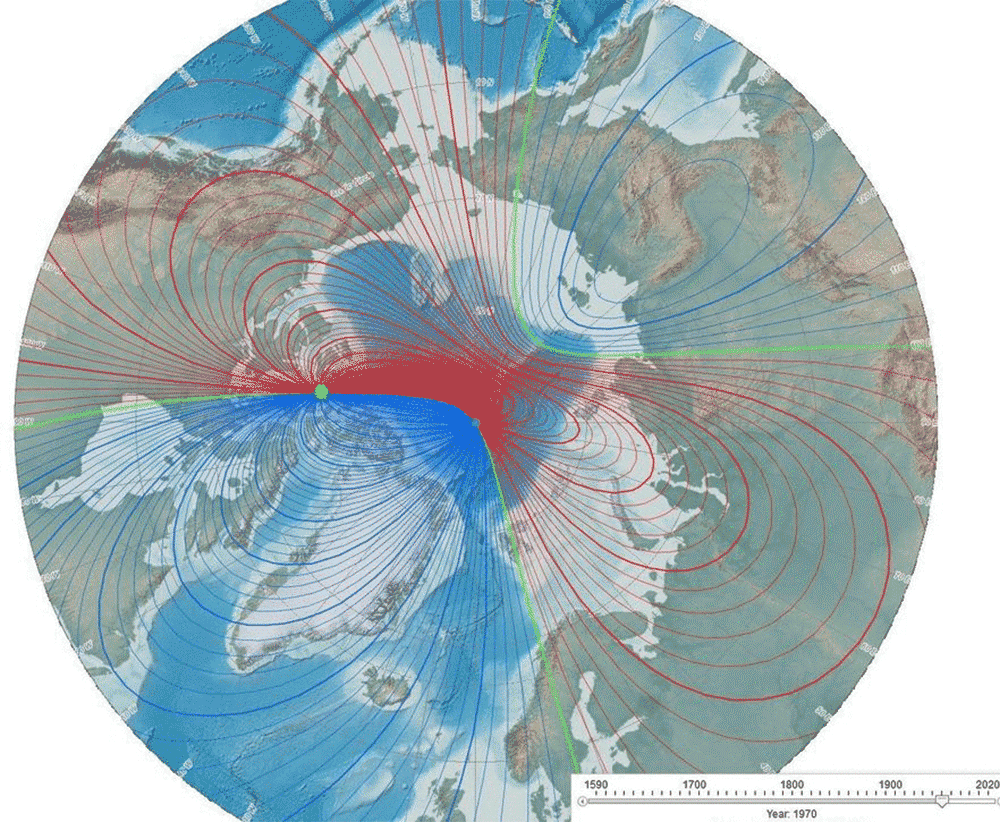
This animation shows the movement of the north magnetic pole at 10-year intervals from 1970 to 2020. The red and blue lines indicate “declination,” the difference between magnetic north and true north depending on where one is standing; on the green line, a compass would point to true north.
In her article The Magnetic Field Is Shifting. The Poles May Flip. This Could Get Bad.
“The shield that protects the Earth from solar radiation is under attack from within. We can’t prevent it, but we ought to prepare.” 01.26.2018 / BY Alanna Mitchell
Is there a growing danger of Earth’s magnetic shield, what shields us from harmful cosmic rays, about to flip? Can the internal vortexes of the planet’s mantle reverse itself? Would it damage or destroy our electric grid and communications? In the article it says:
quote:How bad could it be? Scientists have never established a link between previous pole reversals and catastrophes like mass extinctions. But the world of today is not the world of 780,000 years ago, when the poles last reversed, or even 40,000 years ago, when they tried to. Today, there are nearly 7.6 billion people on Earth, twice as many as in 1970. We have drastically changed the chemistry of the atmosphere and the ocean with our activities, impairing the life support system of the planet. Humans have built huge cities, industries and networks of roads, slicing up access to safer living spaces for many other creatures. We have pushed perhaps a third of all known species toward extinction and have imperiled the habitats of many more. Add cosmic and ultraviolet radiation to this mix, and the consequences for life on Earth could be ruinous.
I wouldn’t lose sleep over it, but it does make one pause and wonder. Our Neanderthal ancestors survived it, but then they didn’t have iPhones, GPS, and ATMs. Well, at least we’ll have fire. |
    
Ivan Alexander
Username: Humancafe
Registered: 12-2017
| | Posted on Saturday, February 13, 2021 - 03:02 pm: | |
Is Truth Relative?

Of course truth can be relative if it is merely opinion. I may say chocolate ice cream is better than strawberry “and that is the truth,” but that would not qualify it as Truth, for it is merely my opinion. We live in an era where it is fashionable among the more sophisticated to say that ‘truth is relative’ and proceed as if it were spoken a truism. Besides the paradox of claiming something ‘true’ when it is a ‘relative’ truth (how can it be anything other than relative truth?) there is also the corollary to what is called truth is really fiction, so it becomes a game of semantics, of calling fiction true.
If truth is relative, and we live in a relativistic age, then it is also counterintuitive, which makes it paradoxical. For example, Einstein’s theory of Special Relativity is counterintuitive, as is the Quantum state, or the particle-wave duality of light. These concepts have worked their way into our common consciousness, so we accept relativistic and paradoxical ‘truths’ in popular discourse. So in that sense truth is relative, if counterintuitive, and if so we are forced to accept it on faith. “Don’t try to understand it, just accept it.” But faith is accepting a world of magic, where a slight of hand appears to be true. Is it really true, or just a trick? Since the time of ancient Greek thinkers, reason had been employed to separate fact from fiction, or reasonable and testable explanations from superstitious beliefs. Not that they cannot coexist side by side, since the human mind is complex, and comfortable with both fact and fiction, there are reality tests that separate one from the other. For example, does an apple drop off a tree from the force of Earth’s gravity (which is true), or does it fall of its own volition (which is not true)? Relative truth here is a contest between reality and magic, so either it is an act of faith, or fact. But it cannot be both! Where one truth is provable and can be demonstrated, the other is simply an opinion of faith. There is a difference.
This is why science has always employed logical reason, and the exactitude of mathematics, to demonstrate its principles as true. It was not until the concepts of ‘relativity’ that truths were contested scientifically. Prior, fiction was known as fiction, or a magical tale, while tests with predictive ability, with being able to successfully replicate, were accepted a true and factual. (We’re ignoring religious dogma here.) The math behind scientific laws is exact, that there can only be one right answer. In today’s relativistic world it is not necessarily so; there could be more than one right answer. But introduce relative truth into the mix and you get strange results, where more than one answer can be held as valid and true.
This is equally true, in a paradoxical way, in the modern concept of “ethnomathematics”, that there can be more than one right answer. There is one mathematical answer for, let’s say, of White-Eurocentric cultural origin, while there may be other answers to the same equation or problem for a multitude of other ethno-cultures. Which is right? Which imaginative? True or fiction, objective or subjective? Which bridge would you be confident driving over, ethomathematically designed, or proven mathematically with physics? Which is science, which pseudoscience? Where one has the confidence and objective support of the real world, the other defaults to a subjective magical fiction. Which is real, and true? Or which merely opinion, and faith based?
A self contradictive statement cannot be false and true at the same time. When a ‘counterintuitive’ argument is presented as true, it should set off alarms, that it cannot be true and false at the same time. Critical reason would place it as suspect, most likely a trick of semantics, or something missing in our understanding or modeling. When it is counterintuitive, it us most probably wrong, or gibberish.
In a relativistic world of paradox and counterintuitive imagination, both answers can be right. But where one answer supports reality, the other is only supported by our imagination, hence fiction. So is it truth or fiction? The truth is simple, while the alternative is infinitely complex. Therein lies the paradox. ‘Truth’ can be anything we want it to be, but then it is mere semantics. The real answer to ‘what is Truth’ is what reality defines it to be. Everything else is fanciful, of our imagination, and in all probability, relativistically speaking, it risks being untrue.
IDA |
    
Ivan Alexander
Username: Humancafe
Registered: 12-2017
| | Posted on Sunday, September 26, 2021 - 12:57 am: | |
Quadratic equation, if it can equal to Zero, why not to Infinity?
(Merely a divertimento, likely of zero use.)

The standard quadratic equation is written as:
ax^2 + bx + c = 0
In the Wiki link to Quadratic Equation, it says:
quote:If one is given a quadratic equation in the form x^2 + bx + c = 0, the sought factorization has the form (x + q)(x + s), and one has to find two numbers q and s that add up to b and whose product is c.
Seems simple enough, as per their example:
quote:As an example, x^2 + 5x + 6 factors as (x + 3)(x + 2). The more general case where a does not equal 1 can require a considerable effort in trial and error guess-and-check…
Then the answer is twofold, where x = -2, and -3, to satisfy either x being equal to zero, viz., (x+3)=0, and (x+2)=0 (and where 3x2=6).
Now, technically, the equation (x+3)(x+2)=0 cannot exist, as neither (x) can be divided by zero, not doable. But since ancient Babylonian times this quadratic equation had been known, so used since then (though now usually solved algebraically, not with factoring but with a simplified quadratic formula). Therefore, using either function equal to zero is acceptable formally to find x in quadratic equations using factoring.
So the question posed: if it can equal zero, why not infinity?
If, for example, we set the above quadratic to equal infinity:
x^2 + 5x + 6= infinity
it would be as if we put 1/0 on the left, per an earlier discussion where zero x infinity = 1. This then gives us, per factoring:
if (x+3)(x+2)=0 then
1/(x+3)(x+2) = infinity
Now, we know (suppose) zero x infinity = 1, so setting the quadratic to ‘infinity’ instead, working it out, using the same formalism as for ‘equal zero’, we get:
If for example, we set the above quadratic to equal infinity:
x^2 + 5x + 6 = infinity
it would be as if we put 1/0 on the left, per an earlier discussion where zero x infinity = 1. This then gives us, per factoring:
If (x+3)(x+2) = 0 per quadratic, and
set to infinity we now have
1/(x+3)(x+2) = infinity, so that
1/infinity= (x+3)(x+2)=0 then
if 0 x infinity = 1 we get
[(x+3)(x+2)] x infinity = 1 or
infinity = 1/ (x+3)(x+2) same as
(x+3) infinity = 1/ (x+2) or same as
(x+2) infinity = 1/ (x+3) so that
infinity = 1/ (x+3) 1/ (x+2) …
… but how to figure this??
** ? ** ? ** ?
So at infinity, are we same as x = 1/-3 and x = 1/-2 ??
Strange…
Ivan
Also see: Zero x infinity = One …a Code for the Universe |
    
Ivan Alexander
Username: Humancafe
Registered: 12-2017
| | Posted on Tuesday, December 13, 2022 - 08:59 pm: | |
Fusion positive results achieved.
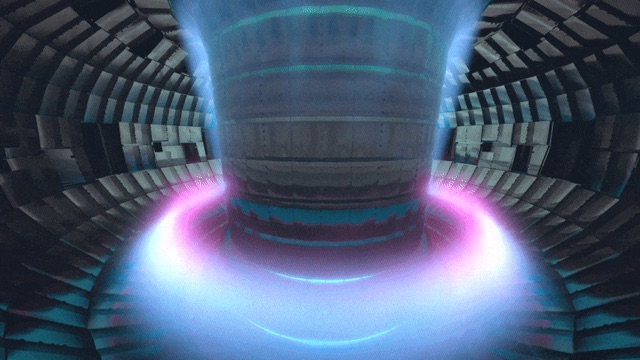
Magnetized Targets Boost NIF Implosion Performance - 8 Dec 2022 (LLNL)
quote:Extensive analysis of the follow-up shots showed that the shortfalls were due primarily to loss of energy from implosion asymmetries and fuel contamination in the hot spot from target capsule material, or “mix.” Researchers attributed the problems to small imperfections in the target capsules, which were of lower quality than the capsule used in the 2021 experiment, perturbations caused by the tiny tubes used to fill the capsules with DT fuel, and slight energy imbalances in the laser beams.
These perturbations may be interpreted that “slight energy imbalances” in the laser beams are not totally dead-on aligned to simulate a micro-blackhole in the fuel capsule, what causes the necessary atomic implosion to release fusion energy.
IDA |
    
Ivan Alexander
Username: Humancafe
Registered: 12-2017
| | Posted on Sunday, August 27, 2023 - 10:56 am: | |
This found on Mars?
 (interactive) (interactive)
This strange formation was allegedly photographed on Mars by rover Curiosity. Was it a natural water or wind sculpted formation, or the creative artwork of a Martian bacterial clay accretion?

This was definitely not a Martian formation, but a creative human construct, allegedly. |
    
Ivan Alexander
Username: Humancafe
Registered: 12-2017
| | Posted on Sunday, November 12, 2023 - 08:35 pm: | |
Some peculiarities of the Big Bang (2017) - continued.
In the “Ask Ethan” series, there is an interesting question: Where are we relative to the Big Bang? (2022)

Big Bang cosmology as understood now
The above article starts with a valid question:
quote:If you think of the Big Bang as an explosion, we can trace it back to a single point-of-origin. But what if it happened everywhere at once?
If the Big Bang happened ‘everywhere at once’ then there is little justification for our being at the ‘center’ of the visible universe, such as we see from observation in every direction, until 13.8 billion light years away it ends with the cosmic microwave background (CMB), which is the end limit of our observation.* What would other observers from other parts of the universe, say millions or billions light years away; what would they see? Would they too find themselves at the ‘center’ of the observable universe?
There is a workaround for this conundrum, as this article further explains:
quote:On the theoretical side, the only reason you’d trace back the apparent motion of all of the galaxies you see back to a point is if they all emerged from some sort of explosion. … But “explosion” is not the same as “expansion.” An explosion is something that happen in space, and the shrapnel from that explosion would move through space. Expansion, however, is something that happens to space, and affects how objects within your Universe perceive one another.
So this is a way to see the Big Bang not as an explosion of the visible universe, but as (explosive?) expansion of space itself. The illustration of this space expansion is the iconic ‘expanding raisin bread’ example, where the raisins represent galaxies moving apart with expansion.
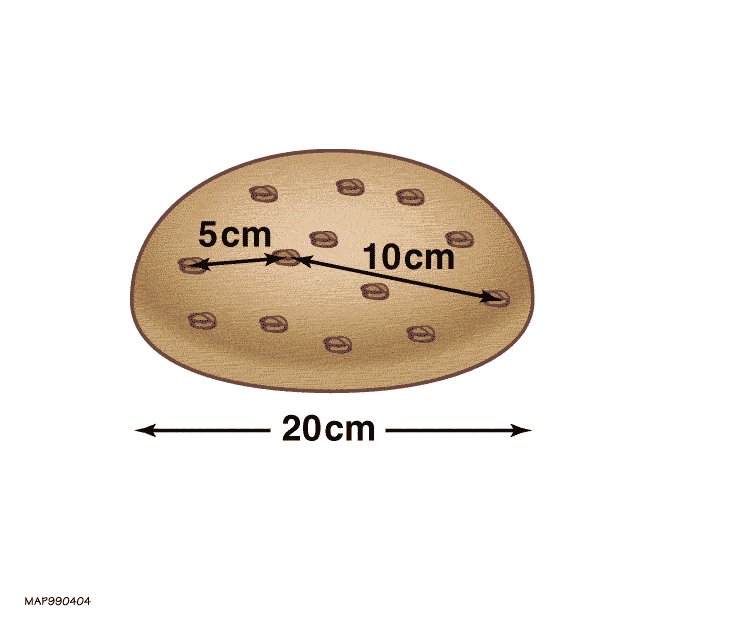
Raisin bread example of space expansion
However, that still leaves unanswered the question of ‘who’s center’ is the Big Bang? It stands to reason that when we look in any direction and come to the CMB perimeter, that we are looking back at ‘time zero’ when the expansion started, 13.8 billion years ago. So the CMB is in fact its own ‘center’ of the universe, where it all began. So we are merely observing it from where we are in it, which fits neatly into the Friedmann–Lemaître–Robertson–Walker metric mathematical models based on Einstein’s General Relativity equations, understood and perfected some hundred years ago as a starting point of Cosmology, the Big Bang Theory. If the universe had a starting point for its cosmic space expansion (immediately after an inputed split second period of inflation), then working back the light redshift takes us back to that origin of near time zero, 13.8 billion years ago, what we today see as the CMB. All very neat, until one considers: where did the ‘raisin bread’ expansion begin? This also had a workaround explanation. As the author stated:
quote:If the Universe is expanding, that has enormous implications for the Big Bang itself. It means the Big Bang wasn’t an explosion that happened at a point, but rather was the beginning of a relentless expansion that started at a particular moment in time. At that moment, the Universe — everywhere and in all locations — was filled with matter-and-energy, and was expanding and cooling in all directions.
Not exactly clarifying the question, but it can lead to another workaround theory, that the universe is a 3-sphere hypersphere, so it curves back on itself, so every part of it is its ‘center’. Seen this way, it saves us the trouble to think of it rationally, but merely accept it on faith in the mathematics. So we have an inverted universe where its origin is on the periphery, what now we see as the CMB… kind of makes sense… Still, one wonders.
So where in the observable, visible universe is the starting point of the Big Bang? Is it anywhere out there we can see? Or is it perhaps invisible, the Big Bang origin exists beyond where our instruments can see? It can’t be a coincidence that ‘we’ are positioned at the origin, as our sun did not form until some 9 billion years after the Big Bang!

At the periphery is ‘time zero’, which is now the CMB, with our solar system in the center
So what we see as Time-Zero-CMB is in fact nothing more than what we can ‘see’ of the universe, full stop. One wonders if Father Georges Lemâitre had considered these questions when he solved the equations to show how the expanding universe had a beginning point (where?) singularity, that was later dubbed as the origin of the Big Bang. Perhaps he had an answer that eludes us today? The author of the article had an interesting workaround this issue, as he put it:
quote:In reality, the Universe has no center, or from another point of view, every point in space and every observer in the Universe can lay equal claim to being at the very center themselves.
So we are left no wiser with this paradox.
Just think how much clearer and cleaner if we were to find that the Hubble Constant redshift of light is ‘not’ from space expansion, but an artefact of how light gravitationally redshifts through the great cosmic distance of space (not tired light) to appear as if space is expanding; but it is not. However, that creates another conundrum, then gravity-G as we know it is ’not’ a universal constant.
*(Note, the ‘inputed’ size of the universe visible to our observations is greater than 13.8 billion light years, as it is believed to be growing at about the Hubble constant, making it now about 46 billion light years across if so.)
IDA
Also see: The further we look, the more we see - red |
|